Fall 2019
Editor’s Note
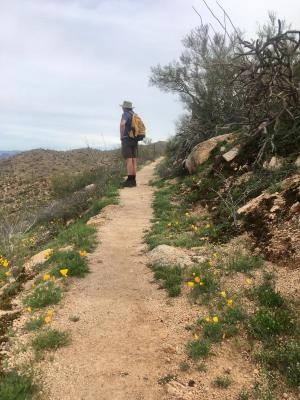 While this issue of Potash Hill was in production, Marlboro announced an ambitious plan to merge with the much larger University of Bridgeport. I call it ambitious because it was not the easy way out—that would have been going fizzle, spending down the college’s endowment until its only assets were a cluster of buildings on a quiet hilltop. Instead, a task force of community members who care deeply about Marlboro found the best strategic partner they could, hopefully providing an influx of diverse students while protecting the college’s student-focused pedagogy and faculty-governed curriculum.
While this issue of Potash Hill was in production, Marlboro announced an ambitious plan to merge with the much larger University of Bridgeport. I call it ambitious because it was not the easy way out—that would have been going fizzle, spending down the college’s endowment until its only assets were a cluster of buildings on a quiet hilltop. Instead, a task force of community members who care deeply about Marlboro found the best strategic partner they could, hopefully providing an influx of diverse students while protecting the college’s student-focused pedagogy and faculty-governed curriculum.
As we all await details of the proposed merger in the coming months, this Potash Hill finds much to celebrate, per usual. From Marlboro’s sparkly new website to the college’s designation as an Ashoka U Changemaker Campus, from the new Data Humanist certificate to the student-led trip to Great Smoky Mountains National Park, this issue is bursting with good news. While the features are on the darker side, focusing on the life-and-death struggle of refugees and the role of ghostly folklore on the Marlboro campus, they still celebrate the diverse and important pursuits—and clear writing—of students and alumni.
As always, Potash Hill applauds the entrepreneurial spirit of Marlboro alumni, from fashion visionary Raghavendra Rathore ’91 in India and coffee prophet Dagmawi Iyasu ’98 in Ethiopia all the way home to Brattleboro’s arts innovator Teta Hilsdon ’87. We will greatly miss collaborating with extraordinary photographer, musician, and holistic education guru Clayton Clemetson ’19, and eagerly anticipate what lies ahead for him. Once again (even if you’ve signed up before), we urge you to let us know what lies ahead for you by signing up on the new, improved Branch Out, Marlboro’s own online community for connecting, engaging, and supporting.
Where is your own entrepreneurial niche, or what was your favorite ghostly anecdote from Howland? As always, we love to hear from our readers at pjohansson@marlboro.edu.
—Philip Johansson
Inside Front Cover
Potash Hill
Published twice every year, Potash Hill shares highlights of what Marlboro College community members, in both undergraduate and graduate programs, are doing, creating, and thinking. The publication is named after the hill in Marlboro, Vermont, where the college was founded in 1946. “Potash,” or potassium carbonate, was a locally important industry in the 18th and 19th centuries, obtained by leaching wood ash and evaporating the result in large iron pots. Students and faculty at Marlboro no longer make potash, but they are very industrious in their own way, as this publication amply demonstrates.
Editor: Philip Johansson
Photo Editor: Richard Smith
Staff Photographers: Clayton Clemetson ’19, David Teter ’20, and Emily Weatherill ’21
Communications Director: Carla Snook
Alumni Director: Maia Segura ’91
Design: Falyn Arakelian
Potash Hill welcomes letters to the editor. Mail them to: Editor, Potash Hill, Marlboro College, P.O. Box A, Marlboro, VT 05344, or send email to pjohansson@marlboro.edu. The editor reserves the right to edit for length letters that appear in Potash Hill.
Potash Hill is available online at Marlboro College’s website: www.marlboro.edu.
Front Cover: Marlboro students face the admissions building and the sweeping horizon beyond.
About Marlboro College 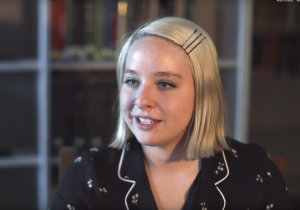 Marlboro College provides independent thinkers with exceptional opportunities to broaden their intellectual horizons, benefit from a small and close-knit learning community, establish a strong foundation for personal and career fulfillment, and make a positive difference in the world. At our campus in the town of Marlboro, Vermont, students engage in deep exploration of their interests while developing transferrable skills that can be directly correlated with success after graduation, known as the Marlboro Promise. These skills are: (1) the ability to write with clarity and precision; (2) the ability to work, live, and communicate with a wide range of individuals; and (3) the ability to lead an ambitious project from idea to execution. Marlboro students fulfill this promise in an atmosphere that emphasizes critical and creative thinking, independence, an egalitarian spirit, and community.
Marlboro College provides independent thinkers with exceptional opportunities to broaden their intellectual horizons, benefit from a small and close-knit learning community, establish a strong foundation for personal and career fulfillment, and make a positive difference in the world. At our campus in the town of Marlboro, Vermont, students engage in deep exploration of their interests while developing transferrable skills that can be directly correlated with success after graduation, known as the Marlboro Promise. These skills are: (1) the ability to write with clarity and precision; (2) the ability to work, live, and communicate with a wide range of individuals; and (3) the ability to lead an ambitious project from idea to execution. Marlboro students fulfill this promise in an atmosphere that emphasizes critical and creative thinking, independence, an egalitarian spirit, and community.
“It’s an experience that will change you,” says Grace Hamilton ’20 (above right), who was one of the students featured in a recent video titled “What you should know about Marlboro College.” Find out what you should know.
Up Front
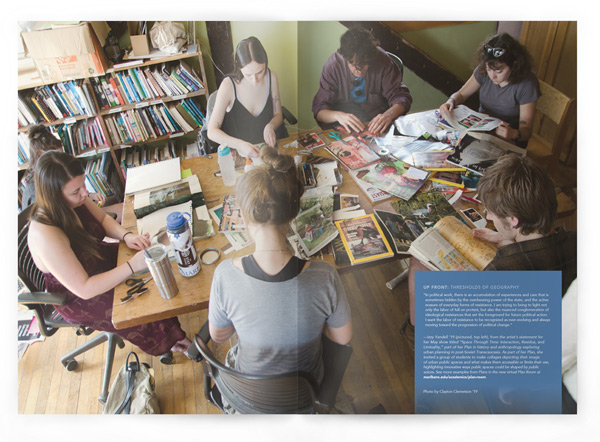
Thresholds of Geography
“In political work, there is an accumulation of experiences and care that is sometimes hidden by the overbearing power of the state, and the active erasure of everyday forms of resistance. I am trying to bring to light not only the labor of full-on protest, but also the nuanced conglomeration of ideological resistances that set the foreground for future political action. I want the labor of resistance to be recognized as ever-evolving and always moving toward the progression of political change.”
—Izzy Yandell ’19 (pictured, top left), from the artist’s statement for her May show titled “Space Through Time: Interaction, Residue, and Liminality,” part of her Plan in history and anthropology exploring urban planning in post-Soviet Transcaucasia. As part of her Plan, she invited a group of students to make collages depicting their image of urban public spaces and what makes them accessible or limits their use, highlighting innovative ways public spaces could be shaped by public voices. See more examples from Plans in the new virtual Plan Room.
Photo by Clayton Clemetson ’19
Clear Writing
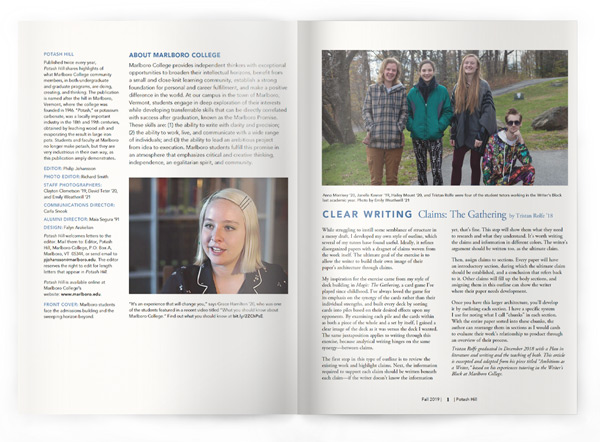
Claims: The Gathering
by Tristan Rolfe ’18
While struggling to instill some semblance of structure in a messy draft, I developed my own style of outline, which several of my tutees have found useful. Ideally, it refines disorganized papers with a dragnet of claims woven from the work itself. The ultimate goal of the exercise is to allow the writer to build their own image of their paper’s architecture through claims.
My inspiration for the exercise came from my style of deck building in Magic: The Gathering, a card game I’ve played since childhood. I’ve always loved the game for its emphasis on the synergy of the cards rather than their individual strengths, and built every deck by sorting cards into piles based on their desired effects upon my opponents. By examining each pile and the cards within as both a piece of the whole and a set by itself, I gained a clear image of the deck as it was versus the deck I wanted. The same juxtaposition applies to writing through this exercise, because analytical writing hinges on the same synergy—between claims.
The first step in this type of outline is to review the existing work and highlight claims. Next, the information required to support each claim should be written beneath each claim—if the writer doesn’t know the information yet, that’s fine. This step will show them what they need to research and what they understand. It’s worth writing the claims and information in different colors. The writer’s argument should be written too, as the ultimate claim.
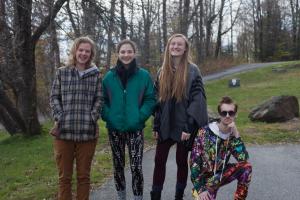 Then, assign claims to sections. Every paper will have an introductory section, during which the ultimate claim should be established, and a conclusion that refers back to it. Other claims will fill up the body sections, and assigning them in this outline can show the writer where their paper needs development.
Then, assign claims to sections. Every paper will have an introductory section, during which the ultimate claim should be established, and a conclusion that refers back to it. Other claims will fill up the body sections, and assigning them in this outline can show the writer where their paper needs development.
Once you have this larger architecture, you’ll develop it by outlining each section. I have a specific system I use for noting what I call “chunks” in each section. With the entire paper sorted into these chunks, the author can rearrange them in sections as I would cards to evaluate their work’s relationship to product through an overview of their process.
Tristan Rolfe graduated in December 2018 with a Plan in literature and writing and the teaching of both. This article is excerpted and adapted from his piece titled “Ambitions as a Writer,” based on his experiences tutoring in the Writer’s Block at Marlboro College.
Letters
Marlboro Memories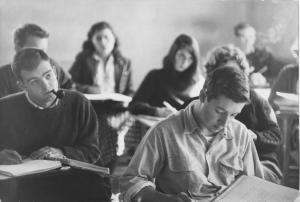 Just thumbing my way through the Spring 2018 Potash HillI feel so proud of the Marlboro community and what it has accomplished in its young life. I have a lot of incredibly good memories, and I think a number of alumni do too, but so few of us write back or celebrate them. What is it about the ’60s? Maybe I can stir something up with these notes from 1963–67.
Just thumbing my way through the Spring 2018 Potash HillI feel so proud of the Marlboro community and what it has accomplished in its young life. I have a lot of incredibly good memories, and I think a number of alumni do too, but so few of us write back or celebrate them. What is it about the ’60s? Maybe I can stir something up with these notes from 1963–67.
Town Meetings were successful: we passed the dog/cat ruling—no pets on campus except Fangio and Tippy; parietal hours were agreed upon—if you are going to do it, be respectful of your room mate; no smoking in the dining hall.
Other memories: dance weekends— we had one even with the recent death of JFK; Pink God Dammit parties to celebrate spring; motorcycles on the iced fire pond; the poker and bridge games that seem to go on all week; homemade beer that exploded in one of the dormitories along with the pen of rabbits in a nearby room; Thanksgiving dinner with the Boydens; the first Wendell Cup ski race.
Marlboro College taught me a lot and I have used these lessons well in my life. Be accountable, be responsible to your community. Give back as much as you have taken, or give more. Enjoy life to the fullest.
—Jennie Tucker ’67
PotashLove What a beautiful and stirring issue of Potash Hill (Spring 2018). I was especially glad to read about Marlboro’s new faculty, who sound as though they quickly absorbed the spirit and promise of this unique place and education. Congratulations on such a good, informative, and aesthetically pleasing issue!
What a beautiful and stirring issue of Potash Hill (Spring 2018). I was especially glad to read about Marlboro’s new faculty, who sound as though they quickly absorbed the spirit and promise of this unique place and education. Congratulations on such a good, informative, and aesthetically pleasing issue!
—Ellen McCulloch-Lovell, former president
Another great issue! It’s everything a magazine like this should be: plenty of substantive, well-written articles, great photos, focus on the people of the college and issues of interest to them. Congratulations.
—Dick Saudek, chair of the board of trustees
I so look forward to each issue of Potash Hilland other mailings from Marlboro. Thanks for another high-quality and informative issue. Although I canceled all magazines, catalogs, and newspapers to save on waste, I can’t bear to not have a printed copy of such a beautiful and meaningful publication.
—Diana Piper, parent of Marty Piper ’20
Climate of Change
Thank you for your note on the climate, and asking for more reflection from alumni. On our Leafhopper Farm (leafhopperfarm. com) in western Washington, we’ve just put in a 20,000-gallon cistern on the property—a temperate rainforest. Also, summer fires are getting redundant. Smoke was the worst in 2018. With record-breaking temperatures of 790F in Seattle in the last two days of winter, I’m sure we’ll be in for another above-normal summer this year too. For someone paying close attention to food security and global environmental failure, I worry we’re seeing a crash. Not only have we forgotten our seat belt, humanity insanely scrambles to slash the airbags.
—Liz Crain ’05
Claim to Fame
I’m a biologist, with a longtime interest in the history of modeling in ecology and population biology. I ran across Dan Toomey’s nice article on Robert MacArthur ’51 in the Summer 2013 issue of Potash Hill. Are you folks aware of the “legendary” meeting that occurred in 1964 (or so) in Marlboro? E. O. Wilson’s account of it in Naturalist has some details: attendees were himself, Richard Levins, Dick Lewontin, Robert MacArthur, and Egbert Leigh, and by Wilson’s account this meeting helped initiate much important research in population biology. So, Marlboro has a claim for playing an important role in the history of ecology.
—Steve Orzack
Empty Promise?
In the last issue of Potash Hill, President Kevin’s message was about the promise of Marlboro to have graduates able to write clearly, follow a big idea to completion, and live in a community. Some students do not know what it is to live in a community, as they are ostracized in a social climate that includes bullying and toxicity. My hope is that rather than “live in a community,” Marlboro instead focuses on creating true community as part of its future growth.
—anonymous parent
View from the Hill
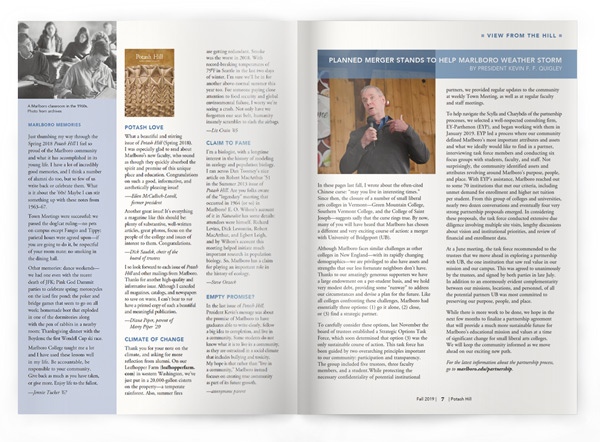
Planned Merger Stands to Help Marlboro Weather Storm
By President Kevin F. F. Quigley
In these pages last fall, I wrote about the often-cited Chinese curse: “may you live in interesting times.” Since then, the closure of a number of small liberal arts colleges in Vermont—Green Mountain College, Southern Vermont College, and the College of Saint Joseph—suggests sadly that the curse rings true. By now, many of you will have heard that Marlboro has chosen a different and very exciting course of action: a merger with University of Bridgeport (UB).
Although Marlboro faces similar challenges as other colleges in New England—with its rapidly changing demographics—we are privileged to also have assets and strengths that our less fortunate neighbors don’t have. Thanks to our amazingly generous supporters we have a large endowment on a per-student basis, and we hold very modest debt, providing some “runway” to address our circumstances and devise a plan for the future. Like all colleges confronting these challenges, Marlboro had essentially three options: (1) go it alone, (2) close, or (3) find a strategic partner.
To carefully consider these options, last November the board of trustees established a Strategic Options Task Force, which soon determined that option (3) was the only sustainable course of action. This task force has been guided by two overarching principles important to our community: participation and transparency. The group included five trustees, three faculty members, and a student. While protecting the necessary confidentiality of potential institutional partners, we provided regular updates to the community at weekly Town Meeting, as well as at regular faculty and staff meetings.
To help navigate the Scylla and Charybdis of the partnership processes, we selected a well-respected consulting firm, EY-Parthenon (EYP), and began working with them in January 2019. EYP led a process where our community defined Marlboro’s most important attributes and assets and what we ideally would like to find in a partner, interviewing task force members and conducting six focus groups with students, faculty, and staff. Not surprisingly, the community identified assets and attributes revolving around Marlboro’s purpose, people, and place.
With EYP’s assistance, Marlboro reached out to some 70 institutions that met our criteria, including unmet demand for enrollment and higher net tuition per student. From this group of colleges and universities, nearly two dozen conversations and eventually four very strong partnership proposals emerged. In considering these proposals, the task force conducted extensive due diligence involving multiple site visits, lengthy discussions about vision and institutional priorities, and review of financial and enrollment data.
At a June meeting, the task force recommended to the trustees that we move ahead in exploring a partnership with UB, the one institution that saw real value in our mission and our campus. This was agreed to unanimously by the trustees, and signed by both parties in late July. In addition to an enormously evident complementarity between our missions, locations, and personnel, of all the potential partners UB was most committed to preserving our purpose, people, and place.
While there is more work to be done, we hope in the next few months to finalize a partnership agreement that will provide a much more sustainable future for Marlboro’s educational mission and values at a time of significant change for small liberal arts colleges. We will keep the community informed as we move ahead on our exciting new path.
While this issue of Potash Hill was in the mail, on August 13, negotiations for this merger were called off. For the latest information about the partnership process, go to our website.
The Eternal Presence of Absence
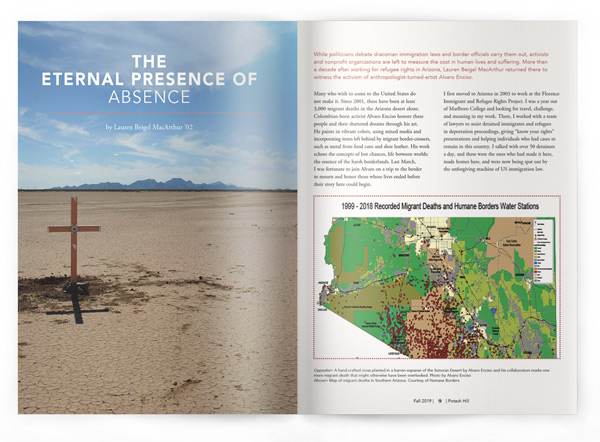
By Lauren Beigel MacArthur ‘02
While politicians debate draconian immigration laws and border officials carry them out, activists and nonprofit organizations are left to measure the cost in human lives and suffering. More than a decade after working for refugee rights in Arizona, Lauren Beigel MacArthur returned there to witness the activism of anthropologist-turned-artist Alvaro Enciso.
Many who wish to come to the United States do not make it. Since 2001, there have been at least 3,000 migrant deaths in the Arizona desert alone. Colombian-born activist Alvaro Enciso honors these people and their shattered dreams through his art. He paints in vibrant colors, using mixed media and incorporating items left behind by migrant border-crossers, such as metal from food cans and shoe leather. His work echoes the concepts of lost chances, life between worlds: the essence of the harsh borderlands. Last March, I was fortunate to join Alvaro on a trip to the border to mourn and honor those whose lives ended before their story here could begin.
I first moved to Arizona in 2003 to work at the Florence Immigrant and Refugee Rights Project. I was a year out of Marlboro College and looking for travel, challenge, and meaning in my work. There, I worked with a team of lawyers to assist detained immigrants and refugees in deportation proceedings, giving “know your rights” presentations and helping individuals who had cases to remain in this country. I talked with over 50 detainees a day, and these were the ones who had made it here, made homes here, and were now being spat out by the unforgiving machine of US immigration law.
In my work I heard many, many stories about border crossings—walks through deserts, dangerous drives, weeks in shipping containers, losing family members, money, and possessions along the way. After two years, my heart and soul were battered, exhausted, and longing to return to Vermont. I did come home to these Green Mountains, but lodged in my heart was that state, that border, and that crisis—those individual lives so devastated by our country’s inhumane immigration policies. After more than a decade, I have begun to revisit Arizona, and this spring I was able to return to the border with Alvaro.
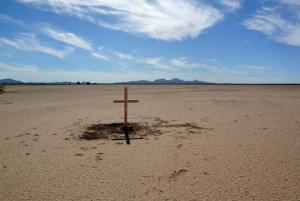 lvaro has created his own “red dot” project, entitled Donde Mueren los Sueños (where dreams die), in which he places hand-crafted wooden crosses on the exact sites of migrant deaths. Using information provided by the Pima County Office of the Medical Examiner, he hikes out into the desert with small groups of helpers to find the “red dots” on the map and pay tribute. This project has recently gained national recognition as the border has become a kind of war zone and political focal point.
lvaro has created his own “red dot” project, entitled Donde Mueren los Sueños (where dreams die), in which he places hand-crafted wooden crosses on the exact sites of migrant deaths. Using information provided by the Pima County Office of the Medical Examiner, he hikes out into the desert with small groups of helpers to find the “red dots” on the map and pay tribute. This project has recently gained national recognition as the border has become a kind of war zone and political focal point.
Donde Mueren los Sueños began as an effort to honor the deceased migrants, and has turned into an action that is drawing new awareness to what has been happening on the border for quite some time. Recent border walls and immigration policies have pushed desperate border crossers into harsher and more dangerous territory, where there is little water and temperatures are well above 100 degrees for many months of the year. Alvaro has placed over 900 crosses, and shows no signs of slowing down.
“No one in Vermont was thinking about the border, and the people who are dying here,” said Alvaro. “No one in Ohio was thinking about it either. But then suddenly the newspaper is mentioning this crazy old guy putting crosses up in the desert, and it catches their attention, and then I hope they’ll begin to think about it.”
While visiting Arizona in March with my family, I had the opportunity to join Alvaro on one of his weekly trips to the border. With Alvaro at the wheel of a high-clearance four-wheel-drive vehicle, I sat wedged between two members of the Tucson Samaritans group, locals who care deeply about the plight of migrant border-crossers. These activists spend their weekends hiking remote canyons and leaving gallons of water and other supplies for migrants who might come that way, something for which they now risk criminal charges.
As we drove south from Tucson toward the small border town of Arivaca, the Samaritans told me about their weekly meetings with a large group of concerned Tucsonians, and how they volunteer at shelters for asylum seekers. They talked about joining protests and civil disobedience actions in places like Arivaca, a town suddenly overrun with US Border Patrols, “militias,” and the harsh reality that current immigration policies have written a death sentence for so many desperate people. Now funneled through this desert corridor and channeled through drug traffickers’ mafia-like hierarchy, migrants face an incredibly perilous journey if they decide to travel overland from Mexico to the United States.
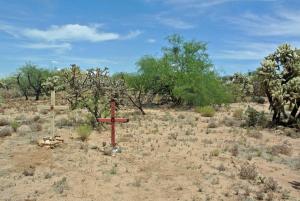 We picked up our navigator in Arivaca, a sturdy young woman who clutched the GPS to her chest and led us to the exact point where skeletal remains had been found in the early 2000s. We drove out rough dirt roads winding through grassy knolls dotted with mesquite, rising in and out of dry, rocky washes. Our navigator pointed out a place she’d tried to camp recently with some friends.
We picked up our navigator in Arivaca, a sturdy young woman who clutched the GPS to her chest and led us to the exact point where skeletal remains had been found in the early 2000s. We drove out rough dirt roads winding through grassy knolls dotted with mesquite, rising in and out of dry, rocky washes. Our navigator pointed out a place she’d tried to camp recently with some friends.
“The Border Patrol kept driving by, slowing down to look at us every time they went by,” she said. “We finally got sick of it and just packed up our campsite and left.” I realized that she could be mistaken for a Mexican, with her dark hair and indigenous-looking cheekbones.
We parked at a cattle corral and walked over a ridge into rustling grass, with an eye out for rattlesnakes. The powerful Arizona sun pressed down upon our backs, and our small group stopped to wipe off sweat, drink from our full water bottles, and have a snack before continuing on. We were eight miles from the border when we reached the site of the red dot, in lovely, rolling hills with views of distant mountains. We set to work digging a hole, placing the salmon-colored cross, pouring in some quick-dry concrete and water, and placing rocks around the base of the cross. We stood for a while in silence. There was no information about this deceased person. No name or cause of death.
I imagined what it would be like to die here. Did this person know that just over the ridge was a dirt road that could be followed to the highway? Were they alone here? Did their family ever find out what happened to them? Alvaro spoke of the “eternal presence of absence”: how this person still occupies an empty chair at the holidays, still represents a question mark in his or her family’s mind. Their family is probably still wondering if someday the phone will ring or they will hear footsteps at their door. “Each of these deaths is a tragedy, and ripples out into others’ lives,” Alvaro said.
We left the lonely cross and three gallons of water (“hidden” in some shrubs), and set off in our vehicle down a rough rancher’s track into the hills. There was a border patrol tower perched on top of one of the higher knolls, and I thought of how unsettling it would be to walk through these hills, knowing that so many eyes could be watching. We could see on the GPS map that another site Alvaro had already marked was not far off this rough road, and finally parked by a small stream. We followed our navigator up a steep slope to the backside of a small tree, a branch looming above us.
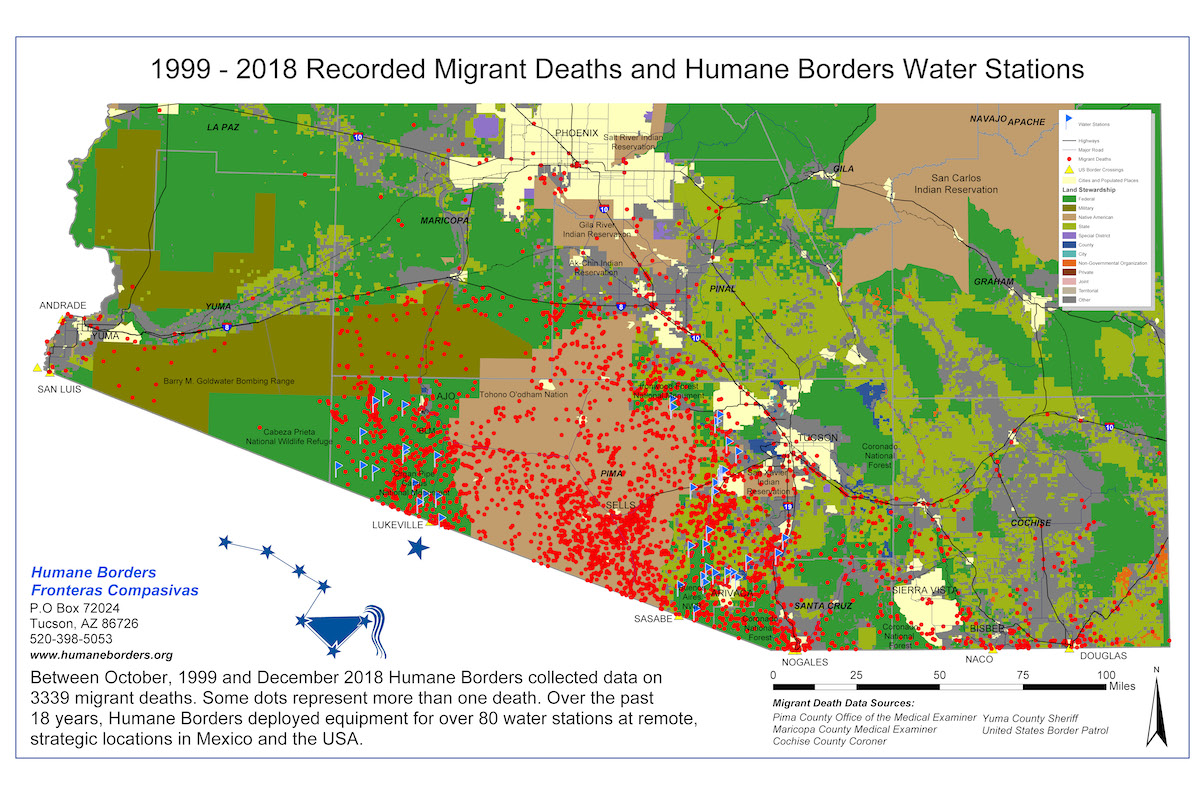 A young man named Isidro Revollar-Herrera had died here, taking his own life. It was painful to imagine what he must have been experiencing to drive him to this fate. Alvaro explained the kind of pain that a slow death by heat and dehydration could inflict, and how seeking relief in hanging oneself with a belt or shirt was not a quick escape either. From Isidro’s last view, we could see the dirt track winding out of sight.
A young man named Isidro Revollar-Herrera had died here, taking his own life. It was painful to imagine what he must have been experiencing to drive him to this fate. Alvaro explained the kind of pain that a slow death by heat and dehydration could inflict, and how seeking relief in hanging oneself with a belt or shirt was not a quick escape either. From Isidro’s last view, we could see the dirt track winding out of sight.
I hope to continue to return to the desert to hike the canyons and enjoy its surreal beauty, but my privilege to do so is never far from my mind. I think of the ridiculous “reality” television shows that glorify “survivors” or those who struggle through obstacle courses to get to an arbitrary finish line. In actual reality, the migrant men, women, and children who navigate the most dangerous route imaginable into our country deserve just as much recognition: for the physical feat and the emotional steeliness they need to embody. They deserve to collapse at the finish line into our arms, to be fed, housed, clothed, and awarded compassion. But even if they make it here, their race has only begun. And if they do not, a humble artist will mark the story of their lives with a painted wooden cross.
Lauren Beigel MacArthur completed her Plan in environmental studies, with a focus on tropical agroecology and Latin American literature, in 2002. She received an MEd at Antioch New England and taught middle school humanities for five years before having two children and running Whetstone CiderWorks with her husband. She currently lives a patchwork Vermont life in Marlboro as a farmer, child advocate, cook, and creative writing teacher, among many other things. For further reading she recommends The Line Becomes a River: Dispatches from the Border, by Francisco Cantú, and The Devil’s Highway, by Luis Alberto Urrea. For more information about Alvaro Enciso and his work, visit facebook.com/alvaro.enciso.5.
Legislating Refugees 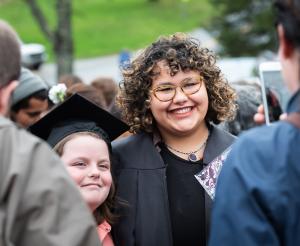 “Trade laws and work programs passed by the United States in nearby Puerto Rico and Mexico have weakened the economies of these already struggling countries for many years,” says Emmett Wood ’19. In a Plan titled “A multidimensional study of the Latino-American narrative,” Emmett explores the history of laws like the Treaty of Paris, the Jones Act, Operation Bootstrap, and the Bracero Program, combined with interviews with Puerto Rican Americans about their experiences. “My research seeks to explore the US’s largely self-inflicted Latino immigration ‘problem,’ and simultaneously allows space for the voices of modern-day Puerto Rican Americans struggling with many of the same issues as those who came before them,” says Emmett. “I pose the question: How does legislation passed between 50 and 100 years ago still affect the lives of Latino Americans today?”
“Trade laws and work programs passed by the United States in nearby Puerto Rico and Mexico have weakened the economies of these already struggling countries for many years,” says Emmett Wood ’19. In a Plan titled “A multidimensional study of the Latino-American narrative,” Emmett explores the history of laws like the Treaty of Paris, the Jones Act, Operation Bootstrap, and the Bracero Program, combined with interviews with Puerto Rican Americans about their experiences. “My research seeks to explore the US’s largely self-inflicted Latino immigration ‘problem,’ and simultaneously allows space for the voices of modern-day Puerto Rican Americans struggling with many of the same issues as those who came before them,” says Emmett. “I pose the question: How does legislation passed between 50 and 100 years ago still affect the lives of Latino Americans today?”
Perspective
Nietzsche vs. Nihilism in America
By Derek Tollefson ’18
It’s hard to be optimistic about politics right now. For those committed to improving political life in America, it’s hard enough to figure out what can or should be done, let alone actually doing it, and thinking it’ll all work out in the end is just naive.
Nietzsche prophesied the advent of nihilism in Europe, and if he’d lived to see the holocaust, Stalin’s gulags, the starvation during Mao’s Cultural Revolution, and the innumerable casualties of both World Wars in the century to follow, he could have said, “I told you so.”
Americans have every reason to be nihilistic: not only are we grappling with more intractable problems than we can count, but we’re exposed to these problems constantly, graphically, and intimately through social media information bubbles. Britain left the EU. People are publishing books and articles about the end of the nation-state system, the primary source of political identity and stability for most of the world over the last two hundred years. The doomsday clock is set at two minutes to midnight, and the man with the nuclear codes is a philandering reality TV host who doesn’t read books.
The writing, it would appear, is on the wall.
Perhaps these concerns are overblown. Perhaps everything will work out in the end. Perhaps not; I can’t say. But in uncertain times people look for certainty anywhere they can, and that is certainly dangerous. Existentialism, and Nietzsche in particular, offers a way to put humanity first without making feckless, empty promises of certainty and stability. In fact, Nietzsche revels in uncertainty, making it into a strength and not a weakness.
If things are moving too quickly to tell right from wrong, if the world is changing too rapidly to really make sense of it, then why not give up on making sense and doing what’s right, which were never really options in the first place, and just focus on making things better? It might require getting our hands dirty, but maybe they were never clean from the start.
Derek Tollefson graduated with a Plan in politics titled “No clean hands: The politics of revenge using Nietzsche and storytelling.” He is now working on the second issue of Milkfist, the literary journal he and a friend founded several years ago, and on finding a PhD program where he can build on his Plan portfolio.
Hauntings on the Hill
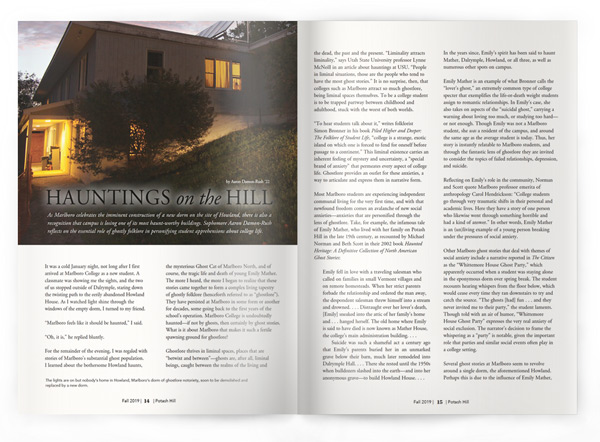
by Aaron Damon-Rush ’22
As Marlboro celebrates the imminent construction of a new dorm on the site of Howland, there is also a recognition that campus is losing one of its most haunt-worthy buildings. Sophomore Aaron Damon-Rush reflects on the essential role of ghostly folklore in personifying student apprehensions about college life.
It was a cold January night, not long after I first arrived at Marlboro College as a new student. A classmate was showing me the sights, and the two of us stopped outside of Dalrymple, staring down the twisting path to the eerily abandoned Howland House. As I watched light shine through the windows of the empty dorm, I turned to my friend.
“Marlboro feels like it should be haunted,” I said.
“Oh, it is,” he replied bluntly.
For the remainder of the evening, I was regaled with stories of Marlboro’s substantial ghost population. I learned about the bothersome Howland haunts, the mysterious Ghost Cat of Marlboro North, and of course, the tragic life and death of young Emily Mather. The more I heard, the more I began to realize that these stories came together to form a complex living tapestry of ghostly folklore (henceforth referred to as “ghostlore”). They have persisted at Marlboro in some form or another for decades, some going back to the first years of the school’s operation. Marlboro College is undoubtedly haunted—if not by ghosts, then certainly by ghost stories. What is it about Marlboro that makes it such a fertile spawning ground for ghostlore?
Ghostlore thrives in liminal spaces, places that are “betwixt and between”—ghosts are, after all, liminal beings, caught between the realms of the living and the dead, the past and the present. “Liminality attracts liminality,” says Utah State University professor Lynne McNeill in an article about hauntings at USU. “People in liminal situations, those are the people who tend to have the most ghost stories.” It is no surprise, then, that colleges such as Marlboro attract so much ghostlore, being liminal spaces themselves. To be a college student is to be trapped partway between childhood and adulthood, stuck with the worst of both worlds.
“To hear students talk about it,” writes folklorist Simon Bronner in his book Piled Higher and Deeper: The Folklore of Student Life, “college is a strange, exotic island on which one is forced to fend for oneself before passage to a continent.” This liminal existence carries an inherent feeling of mystery and uncertainty, a “special brand of anxiety” that permeates every aspect of college life. Ghostlore provides an outlet for these anxieties, a way to articulate and express them in narrative form.
Most Marlboro students are experiencing independent communal living for the very first time, and with that newfound freedom comes an avalanche of new social anxieties—anxieties that are personified through the lens of ghostlore. Take, for example, the infamous tale of Emily Mather, who lived with her family on Potash Hill in the late 19th century, as recounted by Michael Norman and Beth Scott in their 2002 book Haunted Heritage: A Definitive Collection of North American Ghost Stories:
Emily fell in love with a traveling salesman who called on families in small Vermont villages and on remote homesteads. When her strict parents forbade the relationship and ordered the man away, the despondent salesman threw himself into a stream and drowned. . . . Distraught over her lover’s death, [Emily] sneaked into the attic of her family’s home and . . . hanged herself. The old home where Emily is said to have died is now known as Mather House, the college’s main administration building. . . . Suicide was such a shameful act a century ago that Emily’s parents buried her in an unmarked grave below their barn, much later remodeled into Dalrymple Hall. . . . There she rested until the 1950s when bulldozers slashed into the earth—and into her anonymous grave—to build Howland House. . . .
In the years since, Emily’s spirit has been said to haunt Mather, Dalrymple, Howland, or all three, as well as numerous other spots on campus.
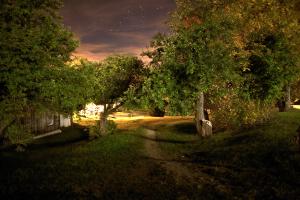 Emily Mather is an example of what Bronner calls the “lover’s ghost,” an extremely common type of college specter that exemplifies the life-or-death weight students assign to romantic relationships. In Emily’s case, she also takes on aspects of the “suicidal ghost,” carrying a warning about loving too much, or studying too hard— or not enough. Though Emily was not a Marlboro student, she was a resident of the campus, and around the same age as the average student is today. Thus, her story is instantly relatable to Marlboro students, and through the fantastic lens of ghostlore they are invited to consider the topics of failed relationships, depression, and suicide.
Emily Mather is an example of what Bronner calls the “lover’s ghost,” an extremely common type of college specter that exemplifies the life-or-death weight students assign to romantic relationships. In Emily’s case, she also takes on aspects of the “suicidal ghost,” carrying a warning about loving too much, or studying too hard— or not enough. Though Emily was not a Marlboro student, she was a resident of the campus, and around the same age as the average student is today. Thus, her story is instantly relatable to Marlboro students, and through the fantastic lens of ghostlore they are invited to consider the topics of failed relationships, depression, and suicide.
Reflecting on Emily’s role in the community, Norman and Scott quote Marlboro professor emerita of anthropology Carol Hendrickson: “College students go through very traumatic shifts in their personal and academic lives. Here they have a story of one person who likewise went through something horrible and had a kind of answer.” In other words, Emily Mather is an (un)living example of a young person breaking under the pressures of social anxiety.
Other Marlboro ghost stories that deal with themes of social anxiety include a narrative reported in The Citizen as the “Whittemore House Ghost Party,” which apparently occurred when a student was staying alone in the eponymous dorm over spring break. The student recounts hearing whispers from the floor below, which would cease every time they ran downstairs to try and catch the source. “The ghosts [had] fun . . . and they never invited me to their party,” the student laments. Though told with an air of humor, “Whittemore House Ghost Party” expresses the very real anxiety of social exclusion. The narrator’s decision to frame the whispering as a “party” is notable, given the important role that parties and similar social events often play in a college setting.
Several ghost stories at Marlboro seem to revolve around a single dorm, the aforementioned Howland. Perhaps this is due to the influence of Emily Mather, as Howland is one of the buildings she is frequently said to haunt. Several students say that their time in Howland was marked by strange noises and disturbances in the night. In the words of one anonymous student cited in The Citizen:
I thought that my neighbors were just noisy. It sounded like they were dropping bowling balls and rolling marbles across the floor. When I would confront them they’d swear they didn’t know what I was talking about. Sometimes when the noise would get bad, I would go upstairs only to discover that no one was in the room above me, or worse yet, that the noises were absolutely not coming from upstairs, but rather, within my own walls.
In narratives such as these, the college student’s anxiety about noisy or otherwise disruptive neighbors is given a supernatural twist. Other stories recounted in The Citizen tell of uneasy sleep within Howland’s rooms. One Marlboro student described waking at 3:00 am “on the dot” every single morning, going outside, and walking the same path. Another said they woke up from a deep sleep with a feeling that “the other person in bed was not my partner” and that “there was someone in the corner.” The student then fell back asleep and later discovered that their partner had had an identical experience. These narratives express an anxiety around loss of sleep and communal living—anxieties all too familiar to busy college students.
One narrative of a student’s experiences at Marlboro North speaks to anxieties around being far from home on a remote, rural campus. The student describes not only a close bond with Ghost Cat, the benevolent feline spirit that is said to haunt the halls of Marlboro North, but also a more threatening supernatural force in the building. “I loved ghost cat,” writes the student in The Citizen, “and got the distinct feeling he was protecting and comforting me from the creepy business in the rest of the building.”
As with all forms of folklore, the ghostlore of Marlboro College is ultimately a form of cultural communication. In his book Interpreting Folklore, Alan Dundes states that folklore “provides a socially sanctioned framework for the expression of critical anxiety-producing problems as well as a cherished artistic vehicle for communicating ethos and worldview.”
Throughout the vast tapestry of Marlboro ghostlore, we see these functions in action. Each and every ghost story represents specific anxieties within the Marlboro student body. Some of these may be anxieties around college in general—noisy roommates, doomed relationships—while others are specific to Marlboro itself, particularly the narratives that focus on the school’s isolated location. As author Colin Dickey says in his book Ghostland, “We tell stories of the dead as a way of making sense of the living.”
Ghostlore helps students embrace the idea of college as liminal space, transforming the “strange exotic island” that is the Marlboro campus into a mysterious and magical place where anything can happen. Through ghostlore, the Marlboro student body grows closer as a community, ensuring that, much like their ghostly subjects, these stories will continue to haunt the Marlboro campus for many years to come.
Aaron Damon-Rush is a sophomore at Marlboro whose main area of interest is “narrative storytelling” in all of its forms— “basically just a fancy way of saying that I enjoy studying stories and the cultural significance they hold.” This article is adapted from an essay written by Aaron for the writing seminar Folklore in Literature and Pop Culture, for which he was awarded a Freshman-Sophomore Essay Prize in May. “Students in my spring 2019 Writing Seminar explored past and current definitions of ‘folk’ and reflected on how folklore and folk processes (transmission from person to person, variation, etc.) persist in the digital age,” says creative writing professor Bronwen Tate. “Aaron did a great job situating his findings within the context of scholarship, both on hauntings and on campus folklore.”
Death’s Covenant with Existence “The ‘whole abyss’ between the present and death is like the abyss between myself and the Other,” says Alex Quick ’19 in his Plan paper titled “The Other in Time.” Alex explores the ethics of 20th-century philosophers Martin Heidegger and Emmanuel Levinas as he grapples with death, which Heidegger said serves as a “total structuring of my temporality.” “For Heidegger, the present moment always has a relationship to death when I am moving toward death in all of my moments,” says Alex, who after graduating joined the Peace Corps in Nepal. “The nothingness in death is inseparable from this present in being.” But for Levinas, death cannot be the primary force that structures time. “Death is not ushering the future into the present because death has no relationship to the present,” says Alex.
On and Off the Hill
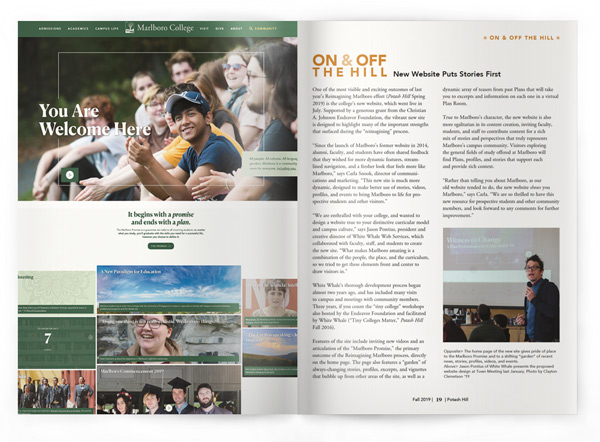
New Website Puts Stories First
 One of the most visible and exciting outcomes of last year’s Reimagining Marlboro effort (Potash Hill Spring 2019) is the college’s new website, which went live in July. Supported by a generous grant from the Christian A. Johnson Endeavor Foundation, the vibrant new site is designed to highlight many of the important strengths that surfaced during the “reimagining” process.
One of the most visible and exciting outcomes of last year’s Reimagining Marlboro effort (Potash Hill Spring 2019) is the college’s new website, which went live in July. Supported by a generous grant from the Christian A. Johnson Endeavor Foundation, the vibrant new site is designed to highlight many of the important strengths that surfaced during the “reimagining” process.
“Since the launch of Marlboro’s former website in 2014, alumni, faculty, and students have often shared feedback that they wished for more dynamic features, streamlined navigation, and a fresher look that feels more like Marlboro,” says Carla Snook, director of communications and marketing. “This new site is much more dynamic, designed to make better use of stories, videos, profiles, and events to bring Marlboro to life for prospective students and other visitors.”
“We are enthralled with your college, and wanted to design a website true to your distinctive curricular model and campus culture,” says Jason Pontius, president and creative director of White Whale Web Services, which collaborated with faculty, staff, and students to create the new site. “What makes Marlboro amazing is a combination of the people, the place, and the curriculum, so we tried to get these elements front and center to draw visitors in.”
White Whale’s thorough development process began almost two years ago, and has included many visits to campus and meetings with community members. Three years, if you count the “tiny college” workshops also hosted by the Endeavor Foundation and facilitated by White Whale (“Tiny Colleges Matter,” Potash Hill Fall 2016).
Features of the site include inviting new videos and an articulation of the “Marlboro Promise,” the primary outcome of the Reimagining Marlboro process, directly on the home page. The page also features a “garden” of always-changing stories, profiles, excerpts, and vignettes that bubble up from other areas of the site, as well as a dynamic array of teasers from past Plans that will take you to excerpts and information on each one in a virtual Plan Room.
True to Marlboro’s character, the new website is also more egalitarian in its content creation, inviting faculty, students, and staff to contribute content for a rich mix of stories and perspectives that truly represents Marlboro’s campus community. Visitors exploring the general fields of study offered at Marlboro will find Plans, profiles, and stories that support each and provide rich context.
“Rather than telling you about Marlboro, as our old website tended to do, the new website shows you Marlboro,” says Carla. “We are so thrilled to have this new resource for prospective students and other community members, and look forward to any comments for further improvement.”
NEH Supports Data Humanist Certificate
Marlboro College has always provided a wealth of interdisciplinary coursework, including courses drawing important links between the humanities and sciences. Now, with the support of a National Endowment for the Humanities (NEH) grant, the college is positioning itself to offer a new undergraduate Data Humanist Certificate Program, making these links even more explicit and demonstrating students’ preparedness for the workplace.
“There is an obvious utility in a student being able to say to a prospective employer, ‘I did some relevant data work,’” said Adam Franklin-Lyons, history professor and one of the faculty members who applied for the grant. “They might have studied literature, but they also worked with a state agency or nonprofit on a data project. If they are applying to do something similar, I think that’s a no brainer.”
The $30,000 NEH Humanities Connections Grant will support the development of a certificate program that provides clear links between humanities coursework and data-driven classes in mathematics, computer science, and biology. The certificate will involve taking two data classes, two humanities classes, and two designated “bridge” classes that are co-taught by faculty from both areas. It will also involve a capstone project that connects with the community in some way, through working for either a government agency, nonprofit, or other organization.
“The ideal is to have four bridge classes in rotation, so they each come around every two years,” said Matt Ollis, math professor, who is also on the grant. “Adam and I will co-teach Cartography once every two years, just as we have in recent years. And Jenny Ramstetter (biology) and Kate Ratcliff (American studies) will continue the Culture and Ecology of the Western US class they’re teaching this semester.”
Other bridge courses will take some development, but one about migrations among humans and other species, to be co-taught by Jenny and Rituparna Mitra (literature and writing), is in the planning stage. The grant team plans to collaborate with colleagues and finalize the certificate program through the Marlboro faculty for a proposed roll-out in fall 2020.
Marlboro Designated Changemaker Campus
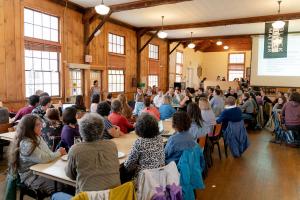 In July, after a long and rigorous selection process, Marlboro College was pleased to announce that it has been designated a Changemaker Campus by Ashoka U. One of approximately 45 leading colleges and universities globally recognized by Ashoka U, Marlboro brings its unique values of shared governance and self-designed learning to this network.
In July, after a long and rigorous selection process, Marlboro College was pleased to announce that it has been designated a Changemaker Campus by Ashoka U. One of approximately 45 leading colleges and universities globally recognized by Ashoka U, Marlboro brings its unique values of shared governance and self-designed learning to this network.
“Institutions in the Changemaker Campus Network set the bar for social innovation and social change in higher education,” says Kate Trzaskos, assistant dean of career education and one of the change leaders who have guided Marlboro through the designation process. “Marlboro is thrilled to be a part of this group, and to share what we have learned through our innovative curricular design and system of community governance.”
Ashoka U is an initiative of Ashoka, the world’s largest network of social entrepreneurs and changemakers. The initiative recognizes colleges and universities globally that, like Marlboro, have embedded social innovation and changemaking into their programming, culture, and operations and are committed to partnering to make this the new norm across higher education. Learn more at marlboro.edu/changemaker.
Students Bring Leadership to Smokies
During spring break in March, five students and OP director Adam Katrick ’07 made a trip to Great Smoky Mountains National Park for hiking, botanizing, and exploring the history of this extraordinary mountain range in Tennessee and North Carolina. The two-week trip was expertly planned and led by students Claire O’Pray ’20 and Lydia Nuhfer ’20—a testament to their leadership skills, including the experience they have gained at Marlboro.
“Being a Bridges leader for the past two years, planning the menu for the Yellowstone trip last year, and taking the Outdoor Leadership class all helped a lot in terms of feeling like I had a handle on the logistical aspects,” says Claire. “Leading this trip was super rewarding. Having people laugh every night, or just sit in silence at a waterfall, and knowing that I made that happen, felt good.”
The group hiked almost every day, walking through biologically diverse and unusual forests to visit waterfalls, caves, and historic sites from the European pioneer era. They also explored Cherokee, North Carolina, and learned about the Indigenous people who thrived in this region for centuries before most were forcibly removed. In the evenings, the hikers shared stories, poetry, music, games, and the camaraderie of adventures together.
“I felt lucky to have the opportunity to plan and lead something from scratch like this as a student—you wouldn’t get the opportunity to do that at a lot of schools, but it’s something the OP here values and prepares us well for,” says Lydia. “I’m studying plant ecology and botany, and the Smokies are a great place to do that, with the highest tree species diversity in the United States.”
One of the many memorable moments occurred while hiking to Mingo Falls, when they saw some graffiti in a six-year-old’s handwriting that read “I love the woberfol.” “We repeated this at every waterfall we went to, and there were many,” says Lydia, who also memorably “dragged” everyone to Waffle House. “In some sense I helped plan this whole trip to Appalachia just so I could go to Waffle House. That’s not entirely true, but it’s a little true.”
On the long drive home, a stop in Maryland at Assateague Island National Seashore was a balm for the weary travelers. It was a gray and stormy afternoon, so they were the only visitors there on the beach trails, where they hiked alongside some of the island’s famous wild horses.
“As soon as we got to the beach, everyone went silent and did their own thing,” says Claire. “It was beautiful to watch some people just kneel down and look at the water, and others run into the waves. I just ran along the sand until I got tired. It was a really quiet, special moment that I loved sharing with everyone there.”
Asylum Seekers Find Respite in Marlboro
In May, after many months of preparation and waiting, two women from Honduras arrived in Marlboro to live, thanks to a partnership between the college and members of the town community. With support from the local Community Asylum Seekers Project (CASP), the effort offers shelter to these immigrants, who would otherwise be living in detention centers, while they wait out the long process of obtaining citizenship.
“I saw this as an enormous learning opportunity and a good reflection of our values,” says President Kevin. “It gives us, as a learning community, a really practical way to play a small but important role in trying to address a major challenge confronting our country and society.” Kevin was approached by two Marlboro residents, Francie Marbury and Edie Mas, who were interested in accepting asylum seekers into the community, but were concerned that living in the rural village would be too isolating. It was agreed that the college would house them during the academic year, when they could be a part of the campus community and participate in meals, events, and other campus happenings.
“I feel really lucky to be involved with this,” says biology professor Jaime Tanner, director of the World Studies Program and a member of the committee that worked to welcome the asylum seekers. Other college community members involved included Spanish language and literature professor Rosario de Swanson, visual arts faculty emeritus Tim Segar, and Emma Huse, former experiential learning and global engagement coordinator, who participated as part of her capstone project at SIT Graduate Institute.
“Right now, people feel a sense of helplessness in the face of the current administration’s policies regarding refugees and asylum seekers,” says Jaime. “This is really a wonderful opportunity to express how much we do welcome others, especially those struggling to find a safe haven.”
It has been a big adjustment for the two women, who come from a suburban area outside the capital city, Tegucigalpa, and were surprised at how rural it is in Marlboro—a car is necessary to get almost anywhere. But they have felt very welcomed by the town community, where they stayed in a private home for the summer, helped residents with their conversational Spanish weekly at the Marlboro Community Center, and even shared some of their amazing Honduran cooking.
These new friends are the fifth family to be welcomed into southern Vermont through the auspices of CASP, which was founded in 2015 for this purpose and has seen its mission grow more urgent in recent years. The others are being hosted in Brattleboro, Rockingham, and Westminster. CASP asks all of us to respect their confidentiality, as their citizenship status may be precarious. Meanwhile, the campus community welcomes them while they wait for their first court hearing, probably sometime next year.
College Stays the Course on Title IX
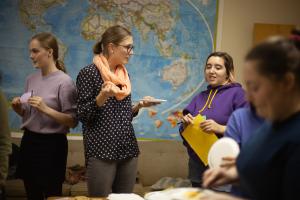 Last fall, the US Department of Education proposed new Title IX regulations that, if made into law, could require significant changes in how Marlboro addresses claims of sexual harassment, sexual assault, and similar rights violations. Despite these new recommendations, and the clamor of debate about their possible impacts, Marlboro has continued to provide a coherent and compassionate response system with many important improvements in recent years.
Last fall, the US Department of Education proposed new Title IX regulations that, if made into law, could require significant changes in how Marlboro addresses claims of sexual harassment, sexual assault, and similar rights violations. Despite these new recommendations, and the clamor of debate about their possible impacts, Marlboro has continued to provide a coherent and compassionate response system with many important improvements in recent years.
“Regardless of the shifting political landscape in Washington around Title IX, Marlboro is still operating under best practices and from a student-centered perspective,” says Patrick Connelly, dean of students. “I think that schools like us that have any kind of moral center are saying, ‘We know what is best practice even if Washington doesn’t fully agree with it.’ We’re going to stay the course as long as there is no legal requirement that we implement the recommendations.”
“Marlboro has worked hard over the years to ensure that we have dealt with Title IX cases fairly, thoroughly, and with respect to our shared community values of safety, learning, and inclusiveness,” said President Kevin in a December letter to the community responding to the new recommendations. “The community has done this work deliberately and carefully in consultation with our Title IX counsel, as well as with consultation with community members. We plan to continue this approach and to address the proposed regulations and implementation of them in this manner.”
As described two years ago in Potash Hill by Robyn Manning-Samuels ’14, then coordinator of sexual respect and wellness, the starting point for Title IX policy at Marlboro and other colleges and universities was the 2011 “Dear Colleague” letter issued by the Obama administration (“Positive Sexuality on Campus,” Fall 2017). Since then, Marlboro has made great strides in prevention and sexual wellness programs, as described by Robyn, but also in adjudicating sexual misconduct cases and providing support for all parties involved. Part of this comes with having a dedicated Title IX coordinator, Brattleboro attorney Jean Kiewel, rather than pinning the role on the dean of students.
“It’s unusual to have someone of Jean’s caliber and qualifications at a school this size,” says Patrick. “It’s a serious challenge to be the dean of students, to support and grow community, when you’re also the investigator and the adjudicator for Title IX cases. Being able to fully be the dean of students is a luxury that doesn’t exist on many small campuses. Meanwhile, I am able to support a Title IX team that meets regularly and is proactive, not just about investigations but about the educational aspects and constant, ongoing building of a safe and respectful community. That’s really unusual too.”
That team includes Megan Grove, coordinator for campus prevention, intervention, and advocacy, who ably filled Robyn’s boots as survivor advocate, but has also been expanded to include Dylan Muller, assistant director of residence life and community standards, who acts in the new role of respondent advisor. The team is completed by Jay Sparks, director of campus safety, who is a resource for students and coordinates reporting by contract security officers and on-call staff.
 “This expanded team is much more qualified to meet the needs of students and respond to concerns,” says Jean. “Not only are we totally on target for meeting the mandates for Title IX, we are doing some really great work that is over and above these mandates. These include offering informal resolution options to cases, and a recent memorandum of understanding with the Vermont State Police that can expedite investigations, if desired. Our Title IX panel has a diversity of conscientious faculty and staff who enthusiastically volunteer their time for the good of the community.”
“This expanded team is much more qualified to meet the needs of students and respond to concerns,” says Jean. “Not only are we totally on target for meeting the mandates for Title IX, we are doing some really great work that is over and above these mandates. These include offering informal resolution options to cases, and a recent memorandum of understanding with the Vermont State Police that can expedite investigations, if desired. Our Title IX panel has a diversity of conscientious faculty and staff who enthusiastically volunteer their time for the good of the community.”
“We are working toward our team and volunteers having trauma-informed training,” says Megan. “It’s important to know how people hold trauma in their bodies and understand that the way trauma manifests can vary widely. One of our main objections to the new Title IX recommendations is just how dangerous and irresponsible it is to put trauma survivors in face-to-face hearings with cross-examinations.” The Title IX team is not entirely ruling out all of the new recommendations, and have been able to distinguish those they feel are appropriate or potentially harmful. For instance, more accommodations are allowed for respondents if needed, such as academic or housing accommodations, and that is in keeping with Marlboro’s practice and approach.
But the team fears the overall effect of a number of the regulations, if enacted, could make the process more limited in scope, as well as more stressful and expensive. The team feels it could lead to less reporting of sexual harassment and sexual violence at Marlboro. They are waiting for more legal tests of the new recommendations, but in the meantime they are well-positioned and well-qualified to respond to cases on campus.
“I can confidently say that in the state of Vermont, for colleges that aren’t Middlebury or UVM, we’re doing it the best,” says Patrick. “It truly is amazing, given our resources and given the added complexity of community governance. We’re nailing it.”
Interns Bring New Energy to Farm and Forest
From May through August, two new interns contributed significantly to ongoing sustainability efforts in two key areas. Jacob Lepkoff and Taliesin Haugh brought a wealth of experience to their roles in the community farm and the forest reserve, respectively, and helped move the college toward goals in each case.
“These new community members help keep things moving over the summer, when there is most to be gained in managing both the farm and the forest reserve, but when our capacity is usually at its minimum,” says Todd Smith, chemistry professor. As the sustainability projects manager, Todd was instrumental in searching for and hiring these two very qualified interns. “This was a trial run for this summer, to be assessed for possible repetition in future years.”
“Working with any biological system, you interact with so many living pieces of that system,” said Jacob, who graduated from Sterling College with a bachelor’s in sustainable agriculture and has worked on a number of farms for 10 seasons. “It’s a joy to work in a living system because you are forced to observe and guess continuously. It is very engaging and rewarding. With every new experience I feel I’m offered a new opportunity to improve my guesses.”
Jacob worked closely over the summer with students Claire O’Pray ’20 and Emerson Gray Koetter ’22, who were able to pursue their own research interests as well as maintain the farm and produce some food. Taliesin, who recently completed his master’s in sustainable development at SIT Graduate Institute, worked more independently on the forest reserve, but was available as a resource for students conducting research there such as Hailey Mount ’20.
“This internship is an exciting opportunity to build the key systems knowledge, frameworks, and skills required to help facilitate a larger societal shift toward sustainable land management, as well as place-based community building,” said Taliesin. “Marlboro took on a huge commitment with this forest reserve, and it’s exciting but daunting to be here at the ground floor of decades of continuous work and research. I hope we set a good foundation for future students and faculty to build on for years to come.”
Three Longtime Faculty Find New Horizons
Marlboro takes pride in how students find their passions through exploring new ideas and perspectives, and how the college’s interdisciplinary approach uniquely prepares them for new horizons. That is no less true for our faculty, three of whom are retiring this year to focus on new projects or directions inspired by their many years spent with Marlboro students and colleagues. Meg Mott (politics), John Sheehy (literature and writing), and John Willis (photography) will all be missed, but the community looks forward to seeing where their next steps take them.
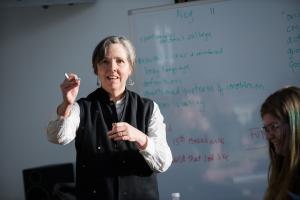 “My favorite part about teaching at Marlboro has been the luxury and solace of teaching old books to a rambunctious group of young thinkers,” says Meg, who has taught politics since 1999. After 20 years, she will be finishing up with her last Plan students this year. “I will miss sitting on the wall in front of the dining hall and watching new and returning students take charge of the campus in September and October.”
“My favorite part about teaching at Marlboro has been the luxury and solace of teaching old books to a rambunctious group of young thinkers,” says Meg, who has taught politics since 1999. After 20 years, she will be finishing up with her last Plan students this year. “I will miss sitting on the wall in front of the dining hall and watching new and returning students take charge of the campus in September and October.”
In popular classes like Debating the American Dream and American Political Thought, Meg boldly blended constitutional law with political theory, two subfields of political science that often don’t have much overlap. She also launched an ambitious semester intensive titled Speech Matters, in fall 2017 and spring 2017, which dove deeply into reframing the debate on addiction and life after incarceration, respectively.
“Thanks to the curricular freedom afforded at Marlboro, I’ve been able to make connections between Machiavelli and Antonin Scalia, Madison and Sandra Day O’Connor,” Meg says. Her political expertise also extended from the classroom to Marlboro’s shared governance model, Community Court, and Town Meeting, where she often served as “parliamentarian.” “Marlboro gave me many opportunities to think out loud in public. Controversial discussions in Town Meeting always sharpened my thought process, and I am so grateful for my worthy opponents.”
Meg’s next adventure involves political theory, the Bill of Rights, and—wait for it—choral music. In the summer of 2017, she created a series called Debating Our Rights, which has run at the Putney Public Library and the Brooks Memorial Library in Brattleboro. The Vermont Humanities Council recently signed her on as one of their speakers, ensuring that the series will be touring around the state. In February 2020, she’ll be presenting on the 19th Amendment at the Vermont State House. “We begin with a look at the political theory behind each of the amendments, the Supreme Court interpretations, and the popular debates those decisions have spawned,” says Meg. What’s more, starting this fall, she’ll be collaborating with composer Neely Bruce of Wesleyan University, who has set the Bill of Rights to music.
“Neely works with community singers, and I lead workshops on the theory and interpretations of select amendments. We conclude with a public performance and discussion on these precious liberties. We are beginning with a performance/workshop in Augusta, Maine, on the First Amendment, and intend to hit each of the 50 states by 2024.” By that time, Meg also hopes to have finished and published her book in progress, Good Clash: The Art of Productive Disagreement. See her recent BCTV presentation on the subject at bit.ly/33qM2xc.
“The political theorist is committed to thinking outside the box or, as Plato might say, ‘thinking outside the cave,’” wrote Meg in a Spring 2016 Potash Hill editorial. The community can rest assured that Meg will remain ever vigilant in this regard, guiding the masses from the mind-numbing shadows of the machine.
• • •
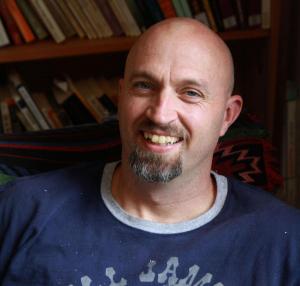 “I liked that Marlboro gave me the freedom to teach what I wanted, when I wanted, and how I wanted,” says John Sheehy, who retired this fall after teaching literature and writing at the college since 1998. “I also liked the way teaching at Marlboro stretched me as a teacher, making me learn new things, and new approaches to old things. But, really, the students—Marlboro students are a joy.”
“I liked that Marlboro gave me the freedom to teach what I wanted, when I wanted, and how I wanted,” says John Sheehy, who retired this fall after teaching literature and writing at the college since 1998. “I also liked the way teaching at Marlboro stretched me as a teacher, making me learn new things, and new approaches to old things. But, really, the students—Marlboro students are a joy.”
With titles like Apocalyptic Hope: The Literature of the American Renaissance and Tell about the South: The South in the American Literary Imagination, John’s literature seminars have covered everything from Faulkner to Emerson, Toni Morrison, Norman MacLean, and Cormac McCarthy. He loves books, and has an almost reverential regard for Moby Dick.
“When you teach a book, and this is true of many books that I love, there are many books that you can find the bottom of,” John said in a Fall 2014 Potash Hill interview. “You teach it once, you teach it twice, you teach it 10 times, and in the end of that you’ve found the edges of it, you know all of the things that are in it. And Moby Dick is not like that. I’ve been teaching it for 20 years and every time I teach it…there’s a bottom somewhere there but I haven’t found it. It’s a beautiful book.”
John explains that writing is an essential part of the learning process because it forces people to organize and present their thoughts with discipline, something people don’t always do when they are simply reading or talking about what they’ve read. For several years he led the Summer Writing Intensive, a weeklong workshop geared toward bringing together veterans as well as civilians through the art of writing, an experience he reflected on in a Chronicle of Higher Education editorial titled “Taking the Fight to the Page.”
It will come as no surprise to students in his Crime and Punishment class that John’s next move is going to law school, something he has contemplated since before his graduate work in literature. He’s not sure where it will lead, but has interests in public interest law, education law, or even going back to teaching.
“I’ve loved teaching legal writing, and would really love the opportunity to develop that as part of a pre-law curriculum somewhere,” says John. “We’ll see. For now, I’m kind of glad to be in the position of not knowing. It’s been a while since I didn’t know what tomorrow would look like.”
What John is certain of is that he will miss pretty much everything about Marlboro, especially teaching and the relationships he’s had with colleagues and, most of all, with students. “Marlboro has more or less made me who I am, so my time at Marlboro has helped inform this new adventure of mine in every conceivable way.”
• • •
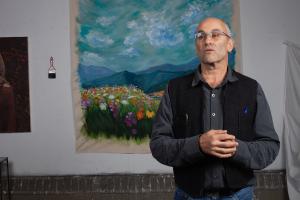 Photography professor John Willis is also retiring after being at Marlboro for 29 years, having started as a part-time adjunct faculty in 1990. He actually first taught a class at the college in 1980, when he had just graduated from Evergreen State College and had moved to the area. Someone invited him to the sauna at Marlboro, and there he learned from students that they were working on building a darkroom but didn’t have a photography teacher. He gladly taught an Intro to Photography class in exchange for taking an art history class with Willene Clark.
Photography professor John Willis is also retiring after being at Marlboro for 29 years, having started as a part-time adjunct faculty in 1990. He actually first taught a class at the college in 1980, when he had just graduated from Evergreen State College and had moved to the area. Someone invited him to the sauna at Marlboro, and there he learned from students that they were working on building a darkroom but didn’t have a photography teacher. He gladly taught an Intro to Photography class in exchange for taking an art history class with Willene Clark.
“The photography program was started by students, just like the film program,” says John, who will continue working with Plan students for this academic year. “I had six students who worked like crazy for no credits, and we set it up in the science building with a darkroom in a mop closet. When I left there was enough interest that they started having part-time adjunct faculty.”
John has enjoyed teaching students who find interesting ways to combine fine arts photography with their other academic work, and has sponsored Plans that spanned the curriculum, from foreign languages to physics. He has challenged students to take photographs that comment on the images they capture, and sees the classroom as a place for constructive criticism.
“I’ve learned so much from the students doing Plans,” says John. “I love the interdisciplinary nature of Marlboro. Teaching the same class over and over, including basic things like ‘this is how a camera works,’ could be boring. What makes it really amazing and interesting is how each student comes to it differently and does different work.”
John is also well known for co-founding In-Sight Photography Project, a Brattleboro-based youth arts program that uses photography as a medium to empower young people to find their own creative voices. Working with five Marlboro Plan students he also co-founded Exposures, In-Sight’s cross-cultural youth arts program that brings participants together from Vermont, Pine Ridge Reservation in South Dakota, and other communities to expand artistic and cultural horizons.
In the coming years John is planning on focusing more on his own work, collaborating with other artists, and probably traveling. He and his wife, Pauline, a nurse, have talked about spending part of the year abroad, applying for Fulbright fellowships, and perhaps even joining the Peace Corps. John credits Marlboro with opening his eyes to the value of travel, having participated in faculty-led trips to Cuba, China, Japan, Cambodia, Pine Ridge Reservation, and the Navajo Nation.
“One way Marlboro affected my life was waking me up to the realization of how amazing the world is, and seeing different cultures and traditions,” says John. “That whatever I grew up thinking was normal is really a construct of my circumstances, and that it’s really helpful to get to know people from different circumstances.”
Also of Note
In May, library staff held their Second Annual Rice-Aron Library Rice Cook-Off, pitting staff members against each other in a heated competition for the best rice dish, literary alluding rice dish, or Rice-Aron Library–alluding rice dish. Despite some stiff competition from the likes of homemade mochi, dragon rolls, and a Rice Krispy treat in the shape of a mouse and called Of Rice and Men, the first prize went to Kate Trzaskos (pictured right), assistant dean of career education, for her cauliflower-rice A Tale of Two Rices. Kate will proudly display the coveted, rice-encrusted, gold-painted trophy until next year.
“I wanted to explain how I see in Spinoza’s philosophical system a way for white Americans to engage in antiracism work as a project of self-love and self-liberation,” says Anna Morrissey ’20, who presented their thoughts at a special summer Collegium Spinozanum at University of Groningen, Netherlands, in July. Anna went there with politics professor Meg Mott, who presented a paper on Spinoza and sexual violence at the same symposium. “Spinoza reveals that to ascribe to racist ideology, consciously or not, is to deny oneself a clear understanding of one’s reality, one’s power, and oneself,” says Anna, who was lauded by other participants for combining Spinoza and critical pedagogy.
In March, The Chronicle of Higher Education ranked Marlboro near the top of the heap in a list awkwardly titled “Where are students most and least likely to be taught by tenured and tenure-track professors?” Marlboro was ranked #2 among four-year private nonprofit institutions, bested only by—some of you may have heard of it—Yale University. Despite its diminutive size, Marlboro rose to the top of the list thanks to a high percentage of tenured or tenure-track faculty (87.5 percent) and the low ratio of students per tenured or tenure-track faculty (7:2). Read more.
After a long wait and and much deliberation, in May the Campus Store announced the talented winner of the “New Fighting Dead Tree Design Contest.” Cedar Van Tassel ’21 topped the competition with an expertly rendered line drawing of a beady-eyed tree that looks pugnacious but not angry, rugged but not mean, dead, perhaps, but still full of that Marlboro fighting spirit (pictured right). “It was a close vote, but we hope everyone will join us in congratulating Cedar and celebrating our new Fighting Dead Tree,” says Sophie Gorjance ’16, campus store manager. “We will work to produce new swag for next year.”
In April, students in SIT professor John Ungerleider’s Conflict and Identity class helped lead a dialogue workshop for the Pan-African Youth Leadership Program at the Vermont Statehouse in Montpelier. The program brings together high school students from across Africa with adult mentors for a three-week US-based training and cultural exchange, including learning about civic rights and responsibilities, respect for diversity, and the importance of community engagement. The Marlboro students were there to help John work with students and teachers from Uganda, Tanzania, Liberia, and Namibia about communication skills and the potential for civil dialogue in their communities and schools
In April, Lydia Nuhfer ’20 and Claire O’Pray ’20 presented a talk, “Digital Analyses of Royal Itineraries from the Crown of Aragon,” at the 40th Annual Medieval and Renaissance Forum at Keene State College. “We looked at digitized itineraries of the Crown of Aragon, using the travel patterns discovered in them to gain a better understanding of medieval travel and how a king’s travel patterns might have affected his reign or geopolitics,” says Claire. Using royal itineraries from between 1291 and 1410, they produced maps and other visualizations to examine differences in travel habits among rulers, in varying political climates, and within individual reigns.
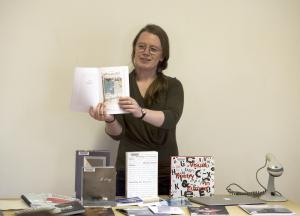 In May, Sophie Gorjance ’16 (pictured right) offered a public presentation in Apple Tree titled “Sensations of Understanding,” the culmination of her year as a postgraduate library fellow. Her fellowship project focused on the many ways the form of a book can convey information and meaning, and can shape one’s experience of “reading.” Specifically, she explored examples of wordless books, concrete poetry books, and books for sensory-impaired individuals, all of which she gathered for the library’s collection. She also discussed how this project grew out of her Plan work in creative writing, and how it fit into the fellowship as a whole.
In May, Sophie Gorjance ’16 (pictured right) offered a public presentation in Apple Tree titled “Sensations of Understanding,” the culmination of her year as a postgraduate library fellow. Her fellowship project focused on the many ways the form of a book can convey information and meaning, and can shape one’s experience of “reading.” Specifically, she explored examples of wordless books, concrete poetry books, and books for sensory-impaired individuals, all of which she gathered for the library’s collection. She also discussed how this project grew out of her Plan work in creative writing, and how it fit into the fellowship as a whole.
In June, Patrick Connelly (dean of students), Catherine O’Callaghan (assistant dean of academic advising), and Kate Trzaskos (assistant dean of career education) joined other college teams attending a Life Design Studio, a four-day immersive training in “life design,” at Stanford University. “Life design comes to Marlboro!” says Kate. “We’re bringing back ideas and curriculum to use with Marlboro students, starting with our first years in all First Year Seminars.” Founded by Bill Burnett and Dave Evans, authors of Designing Your Life, the Life Design Lab applies the principles of design thinking to approaches to college, career, and other life choices.
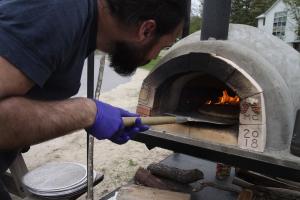 Michael Riley ’09, IT director, has been seen making one or two pizzas in the new portable pizza oven, crafted by students working with ceramics fellow David Eichelberger.
Michael Riley ’09, IT director, has been seen making one or two pizzas in the new portable pizza oven, crafted by students working with ceramics fellow David Eichelberger.
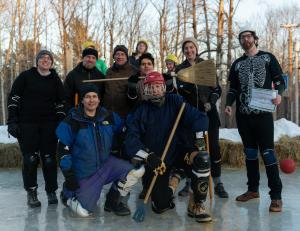 The staff-faculty team, Grim Sweepers, won the annual broomball competition in February, showing students that there is more to life than being young and flexible. Photo by David Teter ‘20
The staff-faculty team, Grim Sweepers, won the annual broomball competition in February, showing students that there is more to life than being young and flexible. Photo by David Teter ‘20
In July, excavation started for the new dormitory building to replace Howland, known by students as “New Howland.” No sign of Emily Mather’s grave yet (see "Hauntings on the Hill").
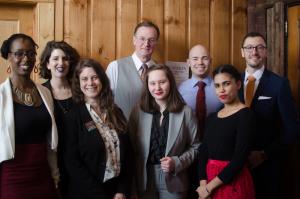 Who are these people? In February, familiar staff members and students took on unfamiliar personas for the annual “Dress for Success” event, part of Career Week. Photo by Clayton Clemetson ‘19
Who are these people? In February, familiar staff members and students took on unfamiliar personas for the annual “Dress for Success” event, part of Career Week. Photo by Clayton Clemetson ‘19
Events

1 As part of the Earth Week festivities in April, local filmmakers Alan Dater and Lisa Merton shared Burned, their award-winning documentary on the accelerating destruction of forests to provide for a burgeoning biomass electric power industry. 2 In March, visiting artist Gourab Ghosh from Jawaharlal Nehru University, India, presented a monologue as part of “Staging Desire in Bengali Jatra: Actor, Queen, and the Self,” followed by a panel discussion on drag traditions. 3 Joel Rosenthal, president of Carnegie Council for Ethics in International Affairs, presented a talk titled “Ethics for a Connected World” in April, part of a series hosted by the presidential seminar course on Engaging the World. 4 Adeel Sultan ’20 and Clayton Sanborn ’22 face off during a performance of Harold Pinter’s The Collection, directed and edited by John Marinelli ’20 as part of an evening of one-act plays titled “The Space Between Us.” 5 Folklore Dominicano Ensemble, a New York-based dance company dedicated to preserving, creating, and presenting dance and music traditions that reflect and celebrate Dominican culture, gave a demonstration and workshop in March. 6 In January, the community enjoyed a performance by Scotti Clifford & Spirit Cries, a Native American rock trio formed in the Badlands of South Dakota and sonically rooted in blues and indie rock inspired by their Oglala Lakota ancestry. 7 In February, curators Caitlin Macbride (pictured) and Lauren Faigle transformed Drury Gallery into an inviting reading room for their traveling library of more than 150 artists’ books titled “Daddy’s Books.”
Focus on Faculty
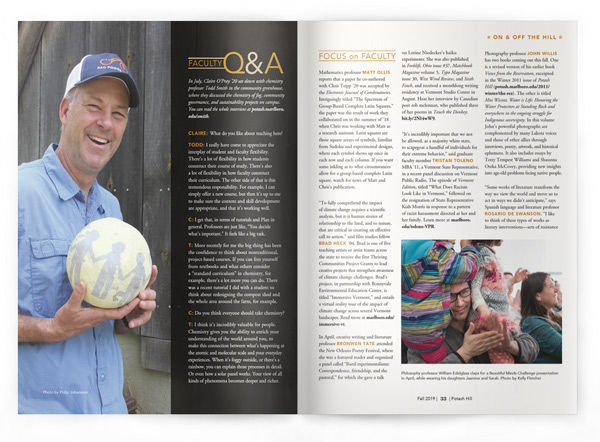
Faculty Q&A
In July, Claire O’Pray ’20 sat down with chemistry professor Todd Smith in the community greenhouse, where they discussed the chemistry of fog, community governance, and sustainability projects on campus. You can read the whole interview.
Claire: What do you like about teaching here?
Todd: I really have come to appreciate the interplay of student and faculty flexibility. There’s a lot of flexibility in how students construct their course of study. There’s also a lot of flexibility in how faculty construct their curriculum. The other side of that is this tremendous responsibility. For example, I can simply offer a new course, but then it’s up to me to make sure the content and skill development are appropriate, and that it’s working well.
C: I get that, in terms of tutorials and Plan in general. Professors are just like, “You decide what’s important.” It feels like a big task.
T: More recently for me the big thing has been the confidence to think about nontraditional, project-based courses. If you can free yourself from textbooks and what others consider a “standard curriculum” in chemistry, for example, there’s a lot more you can do. There was a recent tutorial I did with a student to think about redesigning the compost shed and the whole area around the farm, for example.
C: Do you think everyone should take chemistry?
T: I think it’s incredibly valuable for people. Chemistry gives you the ability to enrich your understanding of the world around you, to make this connection between what’s happening at the atomic and molecular scale and your everyday experiences. When it’s foggy outside, or there’s a rainbow, you can explain those processes in detail. Or even how a solar panel works. Your view of all kinds of phenomena becomes deeper and richer.
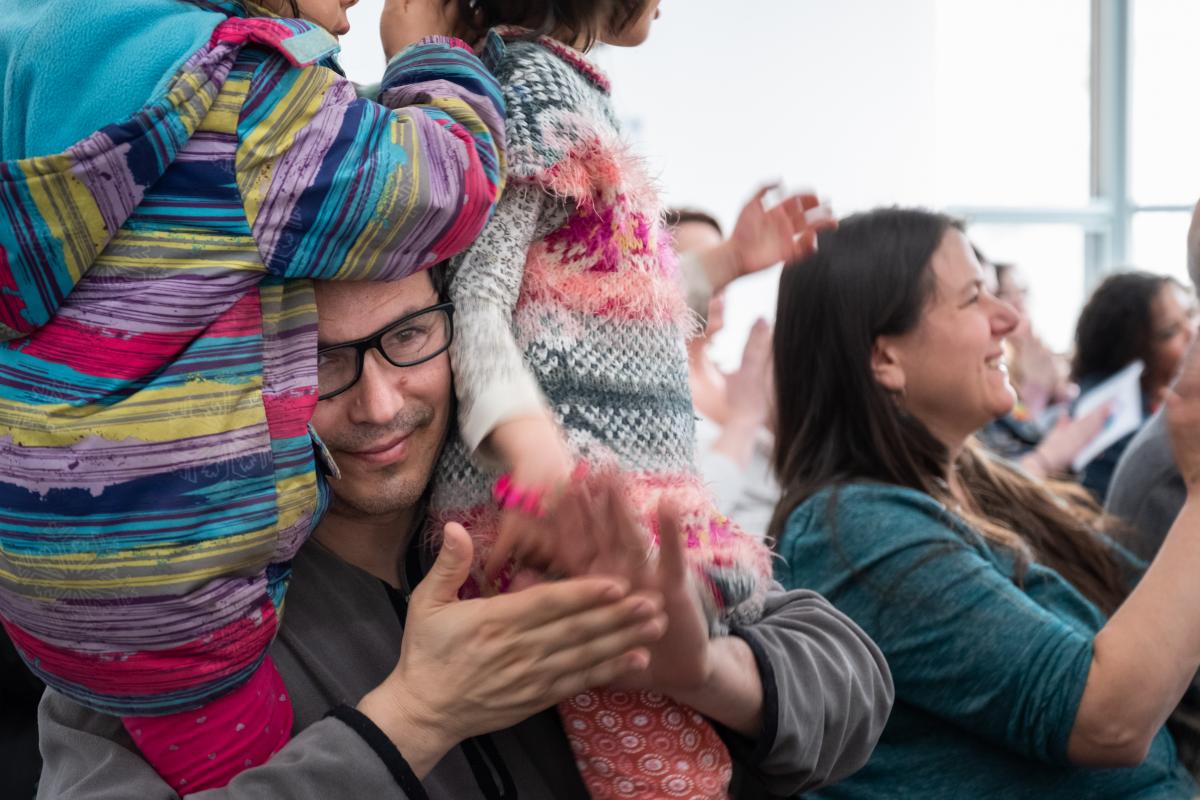 Mathematics professor Matt Ollis reports that a paper he co-authored with Chris Tripp ’20 was accepted by the Electronic Journal of Combinatorics. Intriguingly titled “The Spectrum of Group-Based Complete Latin Squares,” the paper was the result of work they collaborated on in the summer of ’18 when Chris was working with Matt as a research assistant. Latin squares are those square arrays of symbols, familiar from Sudoku and experimental designs, where each symbol shows up once in each row and each column. If you want some inkling as to what circumstances allow for a group-based complete Latin square, watch for news of Matt and Chris’s publication.
Mathematics professor Matt Ollis reports that a paper he co-authored with Chris Tripp ’20 was accepted by the Electronic Journal of Combinatorics. Intriguingly titled “The Spectrum of Group-Based Complete Latin Squares,” the paper was the result of work they collaborated on in the summer of ’18 when Chris was working with Matt as a research assistant. Latin squares are those square arrays of symbols, familiar from Sudoku and experimental designs, where each symbol shows up once in each row and each column. If you want some inkling as to what circumstances allow for a group-based complete Latin square, watch for news of Matt and Chris’s publication.
“To fully comprehend the impact of climate change requires a scientific analysis, but it is human stories of relationship to the land, and to nature, that are critical in creating an effective call to action,” said film studies fellow Brad Heck '04. Brad is one of five teaching artists or artist teams across the state to receive the first Thriving Communities Project Grants to lead creative projects that strengthen awareness of climate change challenges. Brad’s project, in partnership with Bonnyvale Environmental Education Center, is titled “Immersive Vermont,” and entails a virtual reality tour of the impact of climate change across several Vermont landscapes. Read more.
In April, creative writing and literature professor Bronwen Tate attended the New Orleans Poetry Festival, where she was a featured reader and organized a panel called “Rural experimentalisms: Correspondence, friendship, and the pastoral,” for which she gave a talk on Lorine Niedecker’s haiku experiments. She was also published in Forklift, Ohio issue #37, Matchbook Magazine volume 5, Typo Magazine issue 30, West Wind Review, and Sixth Finch, and received a monthlong writing residency at Vermont Studio Center in August. Hear her interview by Canadian poet rob mclennan, who published three of her poems in Touch the Donkey.
“It’s incredibly important that we not be allowed, as a majority white state, to scapegoat a handful of individuals for their extreme behavior,” said graduate faculty member Tristan Toleno MBA ’11, a Vermont State Representative, in a recent panel discussion on Vermont Public Radio. The episode of Vermont Edition, titled “What Does Racism Look Like in Vermont,” followed on the resignation of State Representative Kiah Morris in response to a pattern of racist harassment directed at her and her family. Learn more.
Photography professor John Willis has two books coming out this fall. One is a revised version of his earlier book Views from the Reservation, excerpted in the Winter 2011 issue of Potash Hill. The other is titled Mni Wiconi, Water is Life: Honoring the Water Protectors at Standing Rock and everywhere in the ongoing struggle for Indigenous sovereignty. In this volume John’s powerful photographs are complemented by many Lakota voices and those of other allies through interviews, poetry, artwork, and historical ephemera. It also includes essays by Terry Tempest Williams and Shaunna Oteka McCovey, providing new insights into age-old problems facing native people.
“Some works of literature transform the way we view the world and move us to act in ways we didn’t anticipate,” says Spanish language and literature professor Rosario de Swanson. “I like to think of these types of works as literary interventions—acts of resistance by means of representation—that can produce change.” Rosario wrote three blog posts on “Literature as Resistance” for Massachusetts Humanities, focusing on Mexican feminist Rosario Castellanos, Guinean writer María Nsué, and Afro-Peruvian writer Nicomedes Santa Cruz. Learn more. In July, Rosario led a discussion and presented a paper in a panel devoted to postcolonial research at the American Association of Teachers of Spanish and Portuguese conference in San Diego, California.
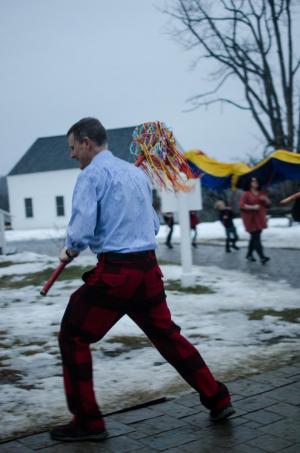 Anthropology professor Nelli Sargsyan co-edited a special issue of History and Anthropology (volume 30, issue 1), with her colleague Larisa Kurtović of University of Ottawa, titled “After Utopia: Leftist imaginaries and activist politics in the postsocialist world.” They also co-authored the introduction to the same issue, and Nelli published an individual article titled “Experience-sharing as feminist praxis: Imagining a future of collective care.” She will be making two presentations at the National Women’s Studies Association Annual Conference, taking place in San Francisco in November, on the theme “Protest, Justice, and Transnational Organizing.”
Anthropology professor Nelli Sargsyan co-edited a special issue of History and Anthropology (volume 30, issue 1), with her colleague Larisa Kurtović of University of Ottawa, titled “After Utopia: Leftist imaginaries and activist politics in the postsocialist world.” They also co-authored the introduction to the same issue, and Nelli published an individual article titled “Experience-sharing as feminist praxis: Imagining a future of collective care.” She will be making two presentations at the National Women’s Studies Association Annual Conference, taking place in San Francisco in November, on the theme “Protest, Justice, and Transnational Organizing.”
Philosophy and environmental studies professor William Edelglass published “‘That is why the Buddha laughs’: Apophasis, Buddhist practice, and the paradox of language” in Journal of Dharma Studies. This summer William gave a series of lectures to Chinese philosophers on environmental philosophy at East China Normal University, in Shanghai, as part of a joint program of the Royal Institute of Philosophy (UK) and the Chinese Academy of Social Sciences. He has been appointed the new director of studies at the Barre Center for Buddhist Studies, located in Barre, Massachusetts, where he has been teaching since 2015. See a recent commentary by William in Lion’s Roar on “How Buddhists can benefit from Western philosophy.”
In April, sculpture professor William Ransom presented an exhibit titled “Hold Everything” in both the Drury Gallery and the lobby of the Snyder Center for the Visual Arts. In all of his work, which spans sculpture, installation, video, and drawing, William creates sculptural situations where viewers can “grasp the tenuousness of time held in the static grip of an object, action, or image.” This exhibition, and an associated artist’s talk and reception, highlighted recent sculptural work in wood and everyday materials, arranged in ways that propose new spatial experiences in familiar spaces.
Theater professor Brenda Foley was a contributing playwright to the Boston production of The Audacity: Women Speak, a multivocal theater project produced in April by Sleeping Weazel at the Boston Center for the Arts. The production was awarded the 2019 Elliot Norton Award for outstanding production by a small theater, presented annually by the Boston Theater Critics Association. Brenda was also an invited speaker for a two-day Wheaton College symposium on Narrative Medicine and the Healing Arts, in collaboration with Charlotte Meehan, Strong Oak Lefebvre, Stephanie Burlington Daniels, Sarah Gambito, Maya Breuer, and Robbie McCauley.
 “The First Amendment is the Queen of Rights,” says politics professor Meg Mott. “Without freedom of speech and freedom of assembly, we don’t have a liberal democracy. But none of the freedoms in the Bill of Rights are absolute. Even speech needs to be regulated in order to protect the public peace. The question is, where do we draw the line?” Meg opened up the First Amendment for debate in June at Brattleboro’s Brooks Memorial Library, part of her ongoing Debating Our Rights series. She followed with a discussion of the Second and Third Amendments in July. Learn more.
“The First Amendment is the Queen of Rights,” says politics professor Meg Mott. “Without freedom of speech and freedom of assembly, we don’t have a liberal democracy. But none of the freedoms in the Bill of Rights are absolute. Even speech needs to be regulated in order to protect the public peace. The question is, where do we draw the line?” Meg opened up the First Amendment for debate in June at Brattleboro’s Brooks Memorial Library, part of her ongoing Debating Our Rights series. She followed with a discussion of the Second and Third Amendments in July. Learn more.
In April, music professor Matan Rubinstein presented the inaugural event for Marlboro’s new “ensemble in residence,” called Marlboro Slipstream Group. Also known as MSG, the ensemble is composed of Matan (piano, electronics), Jake Charkey (cello), Andrew Greenwald (drums, percussion), and Ned Rothenberg (alto saxophone, clarinet, bass clarinet, and shakuhachi). “MSG was conceived as a musical meeting of four performers/composers/ improvisers of wildly different musical backgrounds, to make music that is betwixt and between,” says Matan. The program included the world premiere of Terraplane, a multimovement composition inspired by Jack Womack’s dystopian parallel-universe science fiction novel by the same title.
Commencement 2019
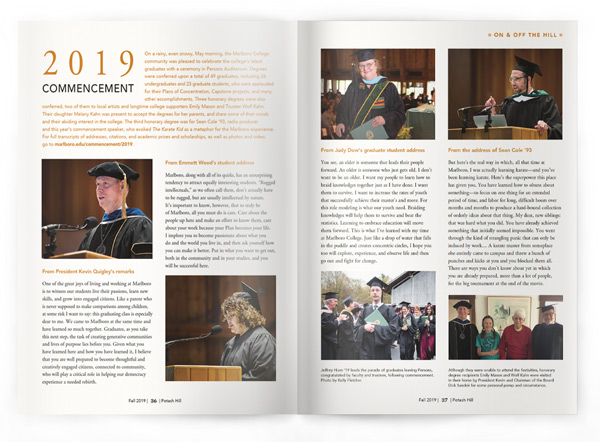
On a rainy, even snowy, May morning, the Marlboro College community was pleased to celebrate the college’s latest graduates with a ceremony in Persons Auditorium. Degrees were conferred upon a total of 49 graduates, including 26 undergraduates and 23 graduate students, who were applauded for their Plans of Concentration, Capstone projects, and many other accomplishments. Three honorary degrees were also conferred, two of them to local artists and longtime college supporters Emily Mason and Trustee Wolf Kahn. Their daughter Melany Kahn was present to accept the degrees for her parents, and share some of their words and their abiding interest in the college. The third honorary degree was for Sean Cole ‘93, radio producer and this year’s commencement speaker, who evoked The Karate Kid as a metaphor for the Marlboro experience. For full transcripts of addresses, citations, and academic prizes and scholarships, as well as photos and video, go to marlboro.edu/commencement/2019.
From President Kevin Quigley’s remarks One of the great joys of living and working at Marlboro is to witness our students live their passions, learn new skills, and grow into engaged citizens. Like a parent who is never supposed to make comparisons among children, at some risk I want to say: this graduating class is especially dear to me. We came to Marlboro at the same time and have learned so much together. Graduates, as you take this next step, the task of creating generative communities and lives of purpose lies before you. Given what you have learned here and how you have learned it, I believe that you are well prepared to become thoughtful and creatively engaged citizens, connected to community, who will play a critical role in helping our democracy experience a needed rebirth.
From Emmett Wood’s student address
Marlboro, along with all of its quirks, has an unsurprising tendency to attract equally interesting students. “Rugged intellectuals,” as we often call them, don’t actually have to be rugged, but are usually intellectual by nature. It’s important to know, however, that to truly be of Marlboro, all you must do is care. Care about the people up here and make an effort to know them, care about your work because your Plan becomes your life. I implore you to become passionate about what you do and the world you live in, and then ask yourself how you can make it better. Put in what you want to get out, both in the community and in your studies, and you will be successful here.
From Judy Dow’s graduate student address You see, an elder is someone that leads their people forward. An older is someone who just gets old. I don’t want to be an older. I want my people to learn how to braid knowledges together just as I have done. I want them to survive. I want to increase the rates of youth that successfully achieve their master’s and more. For this role modeling is what our youth need. Braiding knowledges will help them to survive and beat the statistics. Learning to embrace education will move them forward. This is what I’ve learned with my time at Marlboro College. Just like a drop of water that falls in the puddle and creates concentric circles, I hope you too will explore, experience, and observe life and then go out and fight for change.
From the address of Sean Cole ’93
But here’s the real way in which, all that time at Marlboro, I was actually learning karate—and you’ve been learning karate. Here’s the superpower this place has given you. You have learned how to obsess about something—to focus on one thing for an extended period of time, and labor for long, difficult hours over months and months to produce a hard-bound collection of orderly ideas about that thing. My dear, new siblings: that was hard what you did. You have already achieved something that initially seemed impossible. You went through the kind of strangling panic that can only be induced by work.... A karate master from someplace else entirely came to campus and threw a bunch of punches and kicks at you and you blocked them all. There are ways you don’t know about yet in which you are already prepared, more than a lot of people, for the big tournament at the end of the movie.
Alumni News
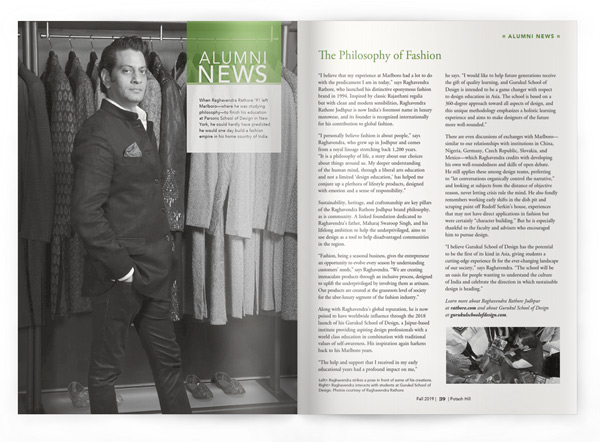
The Philosophy of Fashion
When Raghavendra Rathore ’91 left Marlboro—where he was studying philosophy—to finish his education at Parsons School of Design in New York, he could hardly have predicted he would one day build a fashion empire in his home country of India.
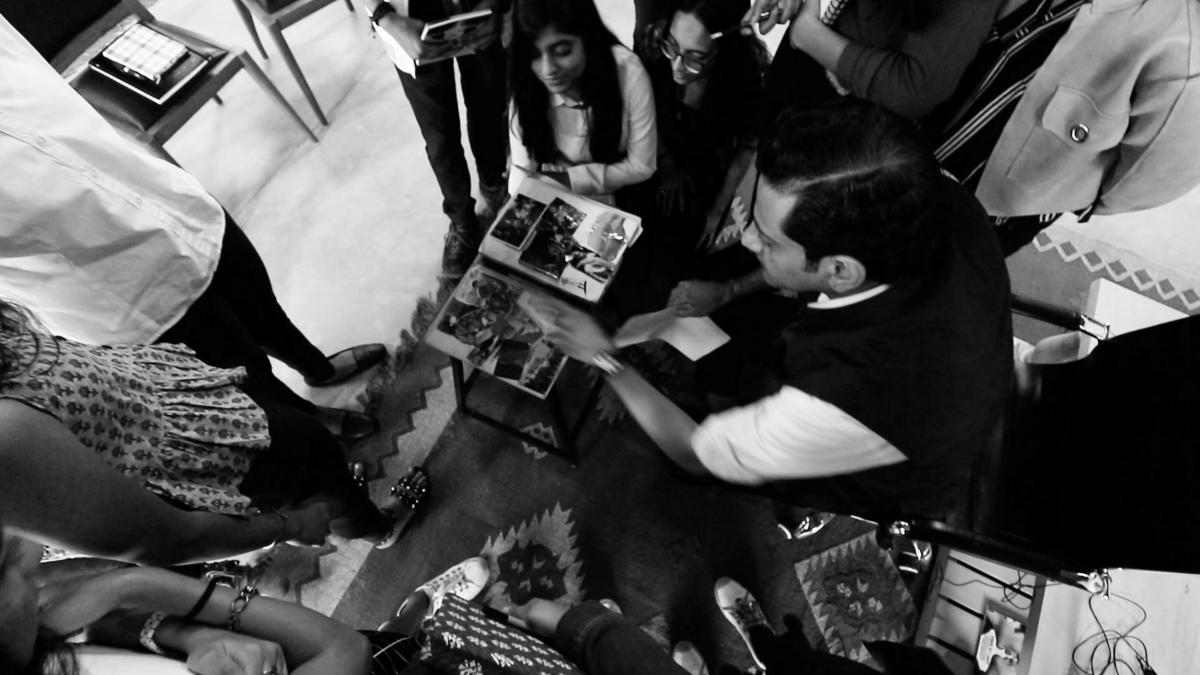 “I believe that my experience at Marlboro had a lot to do with the predicament I am in today,” says Raghavendra Rathore, who launched his distinctive eponymous fashion brand in 1994. Inspired by classic Rajasthani regalia but with clean and modern sensibilities, Raghavendra Rathore Jodhpur is now India’s foremost name in luxury menswear, and its founder is recognized internationally for his contribution to global fashion.
“I believe that my experience at Marlboro had a lot to do with the predicament I am in today,” says Raghavendra Rathore, who launched his distinctive eponymous fashion brand in 1994. Inspired by classic Rajasthani regalia but with clean and modern sensibilities, Raghavendra Rathore Jodhpur is now India’s foremost name in luxury menswear, and its founder is recognized internationally for his contribution to global fashion.
“I personally believe fashion is about people,” says Raghavendra, who grew up in Jodhpur and comes from a royal lineage stretching back 1,200 years. “It is a philosophy of life, a story about our choices about things around us. My deeper understanding of the human mind, through a liberal arts education and not a limited ‘design education,’ has helped me conjure up a plethora of lifestyle products, designed with emotion and a sense of responsibility.”
Sustainability, heritage, and craftsmanship are key pillars of the Raghavendra Rathore Jodhpur brand philosophy, as is community. A linked foundation dedicated to Raghavendra’s father, Maharaj Swaroop Singh, and his lifelong ambition to help the underprivileged, aims to use design as a tool to help disadvantaged communities in the region.
“Fashion, being a seasonal business, gives the entrepreneur an opportunity to evolve every season by understanding customers’ needs,” says Raghavendra. “We are creating immaculate products through an inclusive process, designed to uplift the underprivileged by involving them as artisans. Our products are created at the grassroots level of society for the uber-luxury segment of the fashion industry.”
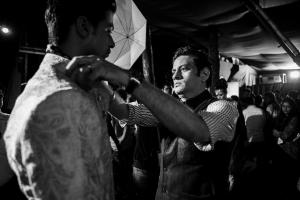 Along with Raghavendra’s global reputation, he is now poised to have worldwide influence through the 2018 launch of his Gurukul School of Design, a Jaipur-based institute providing aspiring design professionals with a world class education in combination with traditional values of self-awareness. His inspiration again harkens back to his Marlboro years.
Along with Raghavendra’s global reputation, he is now poised to have worldwide influence through the 2018 launch of his Gurukul School of Design, a Jaipur-based institute providing aspiring design professionals with a world class education in combination with traditional values of self-awareness. His inspiration again harkens back to his Marlboro years.
“The help and support that I received in my early educational years had a profound impact on me,” he says. “I would like to help future generations receive the gift of quality learning, and Gurukul School of Design is intended to be a game changer with respect to design education in Asia. The school is based on a 360-degree approach toward all aspects of design, and this unique methodology emphasizes a holistic learning experience and aims to make designers of the future more well-rounded.”
There are even discussions of exchanges with Marlboro— similar to our relationships with institutions in China, Nigeria, Germany, Czech Republic, Slovakia, and Mexico—which Raghavendra credits with developing his own well-roundedness and skills of open debate. He still applies these among design teams, preferring to “let conversations organically control the narrative,” and looking at subjects from the distance of objective reason, never letting crisis rule the mind. He also fondly remembers working early shifts in the dish pit and scraping paint off Rudolf Serkin’s house, experiences that may not have direct applications in fashion but were certainly “character building.” But he is especially thankful to the faculty and advisers who encouraged him to pursue design.
“I believe Gurukul School of Design has the potential to be the first of its kind in Asia, giving students a cutting-edge experience fit for the ever-changing landscape of our society,” says Raghavendra. “The school will be an oasis for people wanting to understand the culture of India and celebrate the direction in which sustainable design is heading.”
Learn more about Raghavendra Rathore Jodhpur at rathore.com and about Gurukul School of Design at gurukulschoolofdesign.com.
Class notes are listed by year and include both graduates and nongraduates; the latter are listed under the class with which they are associated.
’58 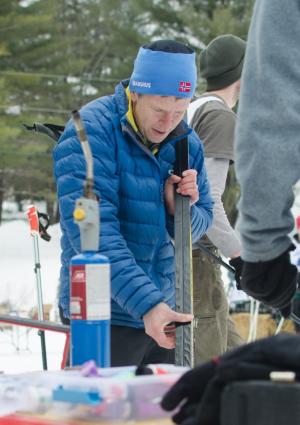 “The magazine that preceded Potash Hill, when Marlboro was tiny, was one that I started, called ETHOS,” writes JAMES PAVLAKIS. “I was the editor, Tinky Turner was the artist, and Sidney Clifford ’59 was our business manager, who got Brattleboro businesses to buy quarter-page ad space so we could pay for printing.” James has a new book of poetry titled Lines of Sight, published by Dorrance Publishing and available on Amazon.
“The magazine that preceded Potash Hill, when Marlboro was tiny, was one that I started, called ETHOS,” writes JAMES PAVLAKIS. “I was the editor, Tinky Turner was the artist, and Sidney Clifford ’59 was our business manager, who got Brattleboro businesses to buy quarter-page ad space so we could pay for printing.” James has a new book of poetry titled Lines of Sight, published by Dorrance Publishing and available on Amazon.
’63
JONATHAN POTTER writes, “Working with a partner to put together one last class at University of Maine at Augusta. It will be an Introduction to Theater, and include history as well as the technical and visual arts. I’ll miss this activity a lot! I’ll be working with adult education students in theater in the fall, also possibly in Commedia dell’Arte. Great magazine, by the way.”
’68
“I can’t throw around sheep all day anymore,” says ANDY RICE in a Martha’s Vineyard magazine profile. The article recounts his life as a sheep farmer and how, since the mid ’90s, he has become the annual “visiting expert in all things sheep” on the island of Martha’s Vineyard, where one farmer called him a “sheep whisperer.” Learn more.
’69
“Ross and I had a wonderful time at the trustee dinner and commencement,” writes LISA INGELFINGER HARRIS. “Being on the campus and being welcomed to those activities felt like such an honor. As you personally know, Marlboro is a unique and amazing college, and being there renewed my awareness of the treasure that it continues to be. We were so impressed with the Plans of the new graduates, as well as the areas of concentration of the master’s students. Caring for people, caring for the world.”
WHITNEY “WHIT” NICHOLS writes, “Over the years I have taught and consulted in various public and private school sectors. My professional background has been invaluable in my advocacy and recovery education mission. Thanks to my and others’ work, Vermont has restructured Medicaid policy to allow for retention of eligibility for persons with disabilities after retirement age. The change helps to encourage my well-being, and is an important step toward acknowledging the value of continued employment among seniors with disabilities. Although some people emerge from homelessness and never look back, I choose to use my experience to advocate and help others.”
’70 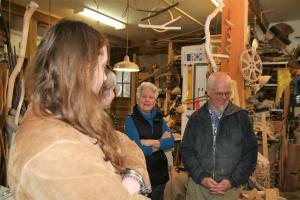 RICHARD GARRETT shared some photos from his time at Marlboro and says, “Being a dyslexic student I was allowed to forego the writing component of comps, and allowed to produce a photo essay shot during comps period. Some interesting visual material resulted...Roland, Audrey, Dick, Wesley, and many, many students. A visual time capsule of late-’60s Marlboro that hasn’t been all scanned yet—all my work was in black and white. I’ve gone on to be an NSF principal investigator/project director as well as an NEH Fellow for my photography and work preserving the Penobscot Native American language.”
RICHARD GARRETT shared some photos from his time at Marlboro and says, “Being a dyslexic student I was allowed to forego the writing component of comps, and allowed to produce a photo essay shot during comps period. Some interesting visual material resulted...Roland, Audrey, Dick, Wesley, and many, many students. A visual time capsule of late-’60s Marlboro that hasn’t been all scanned yet—all my work was in black and white. I’ve gone on to be an NSF principal investigator/project director as well as an NEH Fellow for my photography and work preserving the Penobscot Native American language.”
’71
FREDERICK GRAY writes, “I had the honor of singing again in Berlin Mariencantore, but this time with the (mostly) professional 16-member small chorus. It was heaven to sing with such fine voices. My granddaughter Tallulah is 16 years old, and got into the pre-college summer semester at Brown University! Thrilled to have her on the East Coast.”
’72
“It’s been a busy year,” says HAROLD ZAKON. “Still teaching and doing research at the University of Texas. My wife, Lynne, and I travelled to the most northerly and southerly destinations we have been to—Iceland and New Zealand— on our way to or from conferences and research projects abroad.”
’73
“Marlboro’s wide-ranging appreciation of all the disciplines and how they come together, at one time, in one mind, on one problem, is essential preparation for the future,” says MELANIE GIFFORD, a research conservator at the National Gallery of Art in Washington, DC, in a recent donor profile. Learn more at marlboro.edu/gifford.
In January, United States Artists awarded Marlboro wood carver MICHELLE CHASSE HOLZAPFEL a $50,000 grant in the craft category of its fellowship program. As might be expected, Michelle is “excited and delighted” about the award, which is entirely unrestricted. “I think one reason United States Artists was attracted to what I do was because of my long-standing commitment to the community,” says Michelle. “And, of course, because I was a woman woodworker.” Learn more.
“Our goal is to provide a warm, welcoming, comfortable space,” says ANDY HORTON in a May Commons article, referring to the town library in the recently established Marlboro Community Center. “Marlboro is one of the few Vermont towns that didn’t have a library.” Andy has been joined in her efforts by others from the college community, including DIANNA NOYES ’80, retired professors Cathy Osman and Carol Hendrickson, Felicia Tober (partner of retired professor Jim Tober), and Gemma Ollis (partner of math professor Matt Ollis). Learn more.
’79
In April, as part of National Poetry Month, DAN TOOMEY gave a talk in Brattleboro on Robert Frost and his role in Marlboro College and education in general. The roundtable talk was sponsored by the NEH-supported Brattleboro Words Project, for which Dan is also putting together some recordings on the same subjects.
’80
“A 210-year-young stone farmhouse in southern Pennsylvania became our new home this year,” says STEVE SMITH. “My wife seems determined to farm as much of the six-acre plot as she can, and to name every deer, groundhog, and baby fox she sees. I am more focused on how to get WiFi to work through two-foot stone walls. For the last decade I have led the live content program at the media and marketing trade publisher MediaPost. I program and host over 20 ‘Insider’ retreats for marketing and media professionals to share ideas, experiences, and forecasts. Marlboro helped me discover my critical intelligence and gave me the confidence to deploy it.”
Teta Hilsdon ’87: Bringing Ceramics to the Community 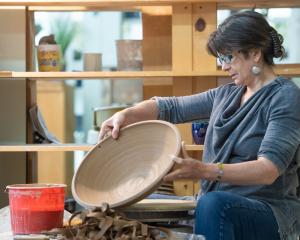 “My desire to create something of value to my community is much stronger than when I was younger,” says Teta Hilsdon, a longtime potter who opened Wheelhouse Clay Center in Brattleboro in May. “I’ve worked as a potter, renting at several group studios, and I’ve done years of administrative work in the arts. I wanted to bring together all my skills into my own business.”
“My desire to create something of value to my community is much stronger than when I was younger,” says Teta Hilsdon, a longtime potter who opened Wheelhouse Clay Center in Brattleboro in May. “I’ve worked as a potter, renting at several group studios, and I’ve done years of administrative work in the arts. I wanted to bring together all my skills into my own business.”
Co-founded with fellow potter Shari Zabriskie, Wheelhouse offers many ways for people who enjoy clay to be engaged, such as work space, classes, and workshops (including by Diane Echlin ’91). Monthly guided Clay Play Date Nights offer three hours of creative fun for the curious and adventuresome, and the gallery shows the work of owners, members, and invited guests.
“Potters who want to work in community are an exceptionally interesting and grounded bunch,” says Teta, who was a co-founder of Brattleboro Clayworks in 1983 along with Marlboro alumni Matt Tell ’81 and Elysse Link ’81. “We love being in the heart of town where people can easily find us or happen upon us, and our well-equipped, spacious studio has plenty of work space for everyone.”
Teta fondly remembers her time at Marlboro, where she did a Plan in philosophy with a focus on Plato. “Transferring to Marlboro was a step down in resources but an enormous step up into a world of guidance from ceramics teacher Orv Wright,” she says. “His was a very Marlboro approach, and it set the tone for my own bearing in pottery forever more.”
’88
ATHAR KHAN has accepted a new position at Delta Airlines as director of Asia-Pacific GMNA and TMC Sales, based in Seoul, South Korea. He works closely with Delta’s local sales teams in China, Japan, Korea, Australia, and Southeast Asia, as well as airline partners in the region, to develop new programs and drive revenue growth. Athar returns to Delta from his role as a vice president for Jet Airways.
’90 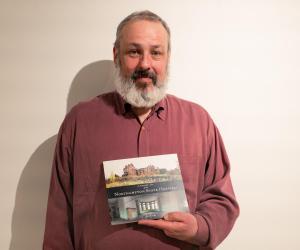 A lecturer in psychology at University of Central Florida, MARTHA HUBERTZ was awarded the 2019 Schell Award for Innovative Writing in the Disciplines, part of the Writing Across the Curriculum Program. “Even in the online classes I have taught, I attempt to tie course information to current events and the other disciplines, and I find that students respond well to this interdisciplinary approach to teaching,” Martha says. Learn more.
A lecturer in psychology at University of Central Florida, MARTHA HUBERTZ was awarded the 2019 Schell Award for Innovative Writing in the Disciplines, part of the Writing Across the Curriculum Program. “Even in the online classes I have taught, I attempt to tie course information to current events and the other disciplines, and I find that students respond well to this interdisciplinary approach to teaching,” Martha says. Learn more.
’92
In June, ERICA KENT received her MFA in writing from Vermont College of Fine Arts. She also had two stories published this spring in The Brooklyn Rail.
’95
MARK GENSZLER is starting a new position as the priest at a tumbling-down old church in Cobble Hill, Brooklyn. He notes that it was the parish church of Richard Upjohn, prominent architect of the Gothic Revival, “a subject I spent a lot of time thinking and writing about with Kate Ratcliff and Willene Clark back in the day. How to give an historic landmark new space? Where to find the partners and millions of bucks necessary? Arts organizers, community activists, urban ecologists— drop me a line and share your wisdom. Or just come say hello!”
’96
ERIN PETERS writes, “I’m still in Los Angeles, working on a TV show as an assistant editor in post production. Last winter I was on Madam Secretary, a CBS show. The summer of 2018 I was on Haunting of Hill House for Netflix. It has been an amazing year!”
’97
In July, JON GITELSON debuted his newest project-in-progress, titled FREE!, which currently consists of roughly 250 found signs, at Gravity Gallery in North Adams, Massachusetts. Jon also curated an exhibit at the Brattleboro Museum and Art Center titled Angus McCullough, Coincidence Control, which was featured in Art New England and is on view until September 23. “I have been a huge fan of Angus’ work for some time, and this will be the first exhibition I have curated at BMAC,” says Jon. This winter, the Chicago Transit Authority published Elevated: Art and Architecture of the Chicago Transit Authority, which included a four-page spread of Chicago El Stories, Jon’s installation at the Armitage Brown Line Station.
Dagmawi Iyasu ’98: Entrepreneurism on Caffeine 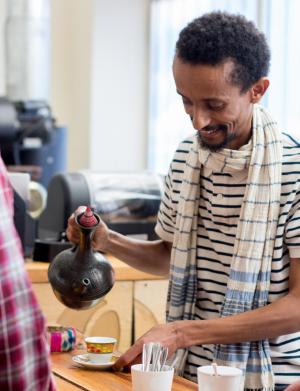 “It seems like my life revolves around coffee,” says Dagmawi Iyasu, a serial entrepreneur, public health practitioner, and coffee researcher in his homeland of Ethiopia. “Coffee is addictive socially—I love the people it brings together. I also love the fact that I get to do chemistry and economics for social impact.”
“It seems like my life revolves around coffee,” says Dagmawi Iyasu, a serial entrepreneur, public health practitioner, and coffee researcher in his homeland of Ethiopia. “Coffee is addictive socially—I love the people it brings together. I also love the fact that I get to do chemistry and economics for social impact.”
Dagmawi is the program manager for Africa at Grounds for Health, a Vermont-based NGO focusing on cervical cancer prevention in coffee-growing communities around the world. He is also an advisor for Ethiopia-based YA Coffee Roasters and Slow Brew Coffee Safaris, companies that his wife, Sara Yirga, owns and manages, where he researches the potential of domestic consumption and coffee tourism in Ethiopia and other African countries.
“It seemed natural to do this as Ethiopia is the birthplace of Coffea arabica and coffee culture,” says Dagmawi. “I am also a co-founder of a few coffee-related businesses in Ethiopia, and soon Vermont. We are trying to bring specialty coffee to the Wilmington area through collaboration, rather than competition, for community development. This is also exciting as our business model depends on bringing smallholder coffee farmers closer to consumers to sustain livelihoods across the value chain.”
Although Dagmawi studied biochemistry and immunology at Marlboro, with special attention to infectious diseases, every part of his Marlboro experience applies to his current endeavors. “It’s hard not to notice Marlboro in my life,” he says. “I am open and bold, and am comfortable doing both general and specialized tasks. I love the idea of failing as long as there is some learning to do.”
’99
CYNTHIA SHELTON was recently hired as a case manager at Northeast Kingdom Council on Aging, according to a May article in the North Star Monthly. She works in Caledonia, Essex, and Orleans counties to help older Vermonters continue to live as independently as possible within the framework of available resources and community supports. Cynthia comes to the council after serving as a nurse’s aide and physical therapy assistant in Nebraska and as the activities assistant at the Vernon Nursing Home. She has also worked for several organizations focused on arts education, world and distance learning, and alternative fuels.
’02
ZANA KONJHODZIC PRUTINA writes, “I moved to Washington, DC, with my family in June 2018, and this fall I started working for Chemonics. Prior to coming here, I spent quite a few years in Bosnia, teaching various management courses at a university. Besides capacity development at Chemonics, I also teach online for Norwich University’s Master of Science in Leadership program. I am enjoying the combination of academic and practical approaches. Last summer I visited KELLY BERGSTRAND and AUGUST WOERNER ’01 in Texas, and KOLI STYLLA ’01 in DC, and we realized it has been 20 years since we’ve met at Marlboro! I have very fond memories of my time there, and I hope now that I am back in the USA I will get a chance to visit.”
’03
In a May article in the Boston Globe, SHURA BARYSHNIKOV was cited as the movement director in an opera production of Margaret Atwood’s classic novel The Handmaid’s Tale. Learn more.
’05 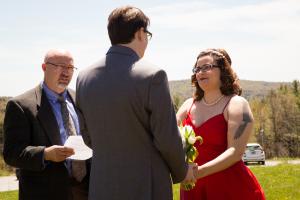 Calcutta Kids, the nongovernmental organization founded by NOAH LEVINSON, was cited in a recent initiative linking Brattleboro to four underserved “sister communities” around the world, as reported in an April Brattleboro Reformer article. Called Compassionate Brattleboro, the project will forge connections between the communities and help support youth programs and other community development work. One of the sister communities is Fakir Bagan, a slum area in Kolkata, India, where Calcutta Kids has helped reduce prevalence of severe undernutrition among children from 13 percent to 3 percent in the past 15 years. Learn more.
Calcutta Kids, the nongovernmental organization founded by NOAH LEVINSON, was cited in a recent initiative linking Brattleboro to four underserved “sister communities” around the world, as reported in an April Brattleboro Reformer article. Called Compassionate Brattleboro, the project will forge connections between the communities and help support youth programs and other community development work. One of the sister communities is Fakir Bagan, a slum area in Kolkata, India, where Calcutta Kids has helped reduce prevalence of severe undernutrition among children from 13 percent to 3 percent in the past 15 years. Learn more.
’08
CARA DOWNEY writes, “Erin Calabria and I created a small press last year called Empty House Press. Our first issue went live with great support and success. We figured it would be fun to let the Marlboro community know about our first issue, and, who knows, maybe get some students interested in submitting some of their work!” Learn more at emptyhousepress.com.
“We have 6,000 miles of streets in New York, and 80 percent of those streets are dedicated to a vehicle that very few New Yorkers are relying on on a daily basis,” says THOMAS DEVITO in a June profile on bklyner. In the article, Thomas, director of advocacy at Transportation Alternatives, discusses his mission to reclaim New York City’s streets from the automobile. “We should see major avenues having dedicated protected spaces for bikes, dedicated protected spaces for buses, pedestrian islands, and make sure they don’t get intruded upon by double parkers.” Learn more at bklyner.com/thomas-devito.
’11
“I have recently relocated to Los Angeles after three years working in the Chicago film community,” says ALICE PACKARD. “I took advantage of the trip out west and did a 15-day road trip where I saw a handful of Marlboro alums along the way including GREGORY MEYERS ’08, SAM LOWENTHAL ’09, SETH SEMPERE ’09, ALEXIA BOGGS ’13, SEAN PYLES ’13, and JOELLA SIMONS ADKINS ’12. It was really a great transition to my somewhat daunting adventure to see so many friendly faces on my way.”
’12
ALEX TOLSTOI completed his master’s degree in historic preservation at University of Vermont, and was on the Marlboro campus in March in his capacity as an expert on the subject (part of the permitting process to replace the “historic” Howland dorm). Learn more about what he’s been up to at marlboro.edu/tolstoi.
“I think that it’s important that there’s more diversity in terms of who’s deciding—when we’re talking about artificial intelligence— what is intelligence?” said MARA EAGLE, a conceptual artist based in Montreal and artist fellow with Berggruen Institute. Mara was speaking at an event titled “Speed Dating for the Mind: Quick Fire Talks of the Arts & Sciences,” hosted by Berggruen Institute and the National Academy of Science in New York City last December. Learn more at marlboro.edu/eagle.
’13
“I’m just in the middle of finishing a master’s program at UCSB in Latin American and Iberian studies,” says ALLEN MAGAÑA. “My thesis project focuses on the development of LGBTI social movements in Portugal in the last decade, specifically how issues of race and economic austerity intersect and affect the dynamics and development of queer social movements. I examine how immigration from Brazil has influenced conceptions of sexuality in Portugal—how sexuality has been made legible through the “other”—and how recent political crises have challenged traditional conceptions of nation, gender, and sexuality.” A violinist in the group Mariachi Arcoris de Los Angeles, Allen is also the singer for the track “Cielo Rojo” on their recent album and a featured singer on most of the popurrís. Learn more at mariachiarcoiris.com.
“I am so inspired by the first-generation winemakers in this growing region,” says THEA CABREROS, sommelier at the Willows Inn on Lummi Island, Washington, as quoted in Wine Enthusiast magazine’s review of the best 100 restaurants. “They come from all different backgrounds, they are talented artists, scientists, chefs, butchers, and some of the bravest people I know. They have one foot in the future and one in the past. They support one another because they know that the gains of one are the gains of all.” Learn more.
DESMOND PEEPLES is publishing a new literary magazine dedicated to supporting rural LGBTQ and POC writers and artists, titled Mount Island, with collaborator Shanta Lee Gander. “We are publishing work online on an ongoing basis and in annual print anthologies,” says Desmond. “Our first new pieces will be released by this fall, and our launch party, which will be a literary game show, is on October 19, 7–9 pm at 118 Elliot during the Brattleboro Literary Festival.” Learn more at mountisland.com.
’15
ROSIE KAHAN says, “This spring, after six years supporting teen participants and adult staff, I won the Todd A. Markley NFTY-Northeast Lifetime Membership Award. Beginning during my time at Marlboro, I volunteered during breaks to staff weeklong retreats. I’ve had the pleasure to work with hundreds of teens and dozens of adults, forming lifelong friendships and relationships that have shaped the path of my career. I work full time at a synagogue outside of Boston that serves about 950 families, and love my work. Recently, my written communication was highlighted during a year-end review, and all I could think was, ‘Thank goodness for Clear Writing!’”
’16
FELIX JARRAR’s fifth opera and master’s thesis composition, Mother Goose, won him the 2019 Lehman Engel Award from Brooklyn College for a particularly outstanding dramatic musical composition that was performed at the school. It is scheduled to be premiered during the 2019–2020 season. He received his master’s of music degree from Brooklyn College with the graduate dean’s award in composition and held the prestigious graduate fellowship for assisting ConTempo, the contemporary ensemble in the conservatory.
’17
“I’ve just finished working full time for Outward Bound California in San Francisco,” says MATT MACINTOSH. “It was a whirlwind of growth and challenge. Very bittersweet to be moving on, and perhaps I’ll return at some point. This fall, I’ll be an instructor for the study abroad program I went on in Chilean Patagonia back in 2015 (Round River Conservation Studies). I look forward to getting my Spanish up a bit and trying out teaching college students.”
’18 In February, CHRIS LAMB contributed to the Brattleboro Words Project conducted by Marlboro College and other partners with support from the National Endowment for the Humanities. Chris, a longtime ski jumper, recorded an evocative memoir about Harris Hill Ski Jump, in Brattleboro, titled “On the Hill.” Harris Hill is a stop on the Brattleboro Words Trail, a self-guided audio walking, biking, and driving tour beginning in Brattleboro. Learn more at brattleborowords.org/project/harris-hill.
Graduate
KELSA SUMMER ROIDT ’13, MBA ’17, who for many years has been an invaluable staff member at the grad school, transitioned to a new job in April. “I’m thrilled to be starting at Habitus Incorporated, a Boston-based B Corp, as a trainer and facilitator,” says Kelsa. “I’ll also be supporting Habitus’ small team in operations and using my B Corp expertise to serve the team in their work as a B Corp. The Marlboro community means so much to me, and I’ll miss my daily interactions with students and the wonderful times we have together on campus. But I’m excited because the new opportunity I’m taking is the kind of work I trained for going back as far at my bachelor’s degree at Marlboro, and throughout the Marlboro MBA program.”
JAMES LAMBERT MSIT ’10 was hired by Castleton University as their director of marketing and communications, according to a June article in the Rutland Herald. James most recently served as the director of advancement for Mount St. Joseph Academy, and before that at College of St. Joseph for six years, serving most recently as associate vice president for marketing and external affairs.
Former Faculty
TIM SEGAR, visual arts faculty emeritus, has had a two-part show at Brattleboro Museum and Art Center from May through October, titled Character Development, including both works on paper and sculptural work. “My practice as an artist has hinged on the dynamic between my two-dimensional works and my three-dimensional objects,” says Tim. “The two represent parallel imaginations, linked in their references to forms and spaces but wholly separate in their dependence on gravity.”
Former dean of students KEN SCHNECK was pleased to announce the publication of LGBTQ Columbus: Images of Modern America, which he co-authored. Ken, an associate professor and director of the Leadership in Higher Education Program at Baldwin Wallace University, has also taken on the role of contributing editor of Prizm Magazine, Ohio’s one-and-only LGBTQ print publication. “This is an amazing opportunity to do exactly what I love doing: amplify the stories of my neighbors, in this case, those of the incredible LGBTQ community here in the Buckeye State,” says Ken.
“As a painter and printmaker living in southern Vermont I am attentive to the landscape’s inherent beauty,” says retired visual arts professor CATHY OSMAN, in a Brattleboro Reformer article on her June exhibit at the Putney Library. “The foundation of my work grows from a deeply felt connection to my natural surroundings.” Learn more.
Former film/video studies professor JAY CRAVEN toured around New England this summer with his latest narrative film, Wetware, a sci-fi/film noir based on the novel by Craig Nova and a product of the Movies from Marlboro program. “Wetware marks a departure for me,” says Jay, as quoted by VTDigger. “I was captivated by Nova’s emotionally stranded main characters, and the ways they navigate the cool and transactional world he vividly describes.” Learn more.
In Memoriam
Grant Li, life changer through language
by Richard Glejzer
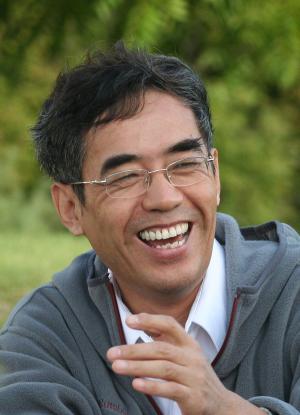 Grant Li, inimitable professor of Chinese language and linguistics, brought energy and passion to everything he did. I have heard from many of those who had the opportunity to work with Grant—students, faculty, staff, and members of Marlboro’s extended community— and they all remember his contagious enthusiasm fondly. From Plan students working in syntax, Grant’s linguistic specialty, to the many students who studied Chinese with him over his 11 years at Marlboro, to our high school partners who praised the great generosity and good will he brought to our dual enrollment programs, his impact on our lives has been huge.
Grant Li, inimitable professor of Chinese language and linguistics, brought energy and passion to everything he did. I have heard from many of those who had the opportunity to work with Grant—students, faculty, staff, and members of Marlboro’s extended community— and they all remember his contagious enthusiasm fondly. From Plan students working in syntax, Grant’s linguistic specialty, to the many students who studied Chinese with him over his 11 years at Marlboro, to our high school partners who praised the great generosity and good will he brought to our dual enrollment programs, his impact on our lives has been huge.
I perhaps heard most from those who travelled with Grant to China, including his home province of Heilongjiang in the north. Those trips were life changing for many, and opened up a world to us that we never would have known if not for Grant. To benefit his language students, Grant worked with his alma mater, Heilongjiang University, to develop a summer language institute for Marlboro students, forging a partnership that eventually led to a full exchange program that brought several Heilongjiang students to Marlboro. Grant was extraordinarily proud of his home in China, and it gave him great pleasure to share both the language and culture with members of our community.
As passionate and excitable as Grant was, he was also a very private man who was devoted to his family. When he received his cancer diagnosis, he asked that I not share that information with colleagues because he wanted to keep everyone’s focus on students and the work we shared. The doctors gave him two years and he fought through seven, teaching his classes, working with Plan students, and maintaining Marlboro’s relationship to Heilongjiang.
I sat with Grant and his wife, Donna, after his last class in May. We talked about his students that year and how grateful he was to have been able to complete the semester, which was in doubt as his health deteriorated through the spring. We also talked about the Red Sox— Grant was an extraordinary sports fan and was the center of many conversations in the dining hall about the highs and lows of Boston sports.
I will most remember the great joy Grant brought to his work, which was so important to him right up until his passing. What drew students to him, more often than not, was his warmth and humor. He will be sorely missed. Grant died on June 14 at home with his family. The Marlboro community honored Grant at the beginning of the academic year with an event on campus.
Richard Glejzer is provost and dean of faculty at Marlboro. You can find our full obituary of Grant at marlboro.edu/grant-li, and join Richard and other community members in contributing to Marlboro in his honor at marlboro.edu/give. If you have your own remembrances of Grant, please share them with Seth Harter at harter@marlboro.edu, and see the tributes of others at potash.marlboro.edu/remembering-grant.
Joseph Herbert Schaeffer, former faculty member
A longtime resident of Marlboro, Joe Schaeffer died in March in his home. He was 80. Joe attended Oberlin College and had a successful musical career before receiving his PhD in anthropology from Columbia University, under the advisement of Margaret Meade. In 1970 he moved to Guilford, and was professor of anthropology at Marlboro College from then until 1987. He then moved to Canada with his third wife and daughter, living there for the next 20 years. During this time he developed methods to support positive communication and conflict resolution, which he shared in workshops and in two books. After living internationally and teaching English in Istanbul, Madrid, and Moscow, he returned to Vermont and took great enjoyment in spending time with his grandchildren, sitting in the sun, reading books, and listening to classical music.
Geoffrey Fallows, classics fellow
Leading classicist and Marlboro’s second Oxford Classics Fellow, Geoffrey Fallows died in June after a long struggle with Parkinson’s disease. He was 77. Geoffrey was just out of Wadham College of the University of Oxford when he served as classics fellow in the 1964–65 academic year. He remained a loyal friend to Marlboro, and served a term as Marlboro’s designated trustee of Huron University, London, in the early 2000s when we maintained a partnership there. Geoffrey served for many years as the classicist and head teacher of Camden School for Girls, in north London. He also served as president of the Joint Association of Classical Teachers, and in that capacity was tireless in his pursuit of gentle political pressure for more attention to classics in education. He also helped launch their publication, Omnibus.
Barbara (Dutton) Dretzin ’55
A resident of Walpole, New Hampshire, Barbara Ann (Dutton) Dretzin died peacefully at her home in March. She was 90. Barbara was born in Brookline, Massachusetts, and attended the Manumit School in Pawling, New York, Cambridge School in Kendal, Massachusetts, and Marlboro College. While there she collaborated with Margaret MacArthur, folk singer and wife of longtime faculty member John MacArthur, in a folk program on the local radio station. At Marlboro she also met William Dretzin ’52, whom she married, and together they served a two-year term in the Peace Corps in Cameroon. She and William, who died in 1997, raised three daughters in Millwood, New York. Mid-life, Barbara returned to New England, where she enjoyed the peace and beauty of Cheshire County, finally settling in Walpole in 1994.
Gretchen Hebb Bean ’57
A longtime resident of Scituate, Massachusetts, Gretchen Hebb Bean passed away peacefully in June. Born and raised in Brattleboro, Vermont, Gretchen was a graduate of Brattleboro High School, and studied biology at Marlboro College. She went on to earn her master’s degree in physiology at the University of Vermont, and finally her PhD in biochemistry at Boston University. Gretchen worked for many years in clinical and research labs, and volunteered as a Scituate Board of Health member for several years. Later in life she founded Commonwealth Laboratories, Inc., where she worked until poor health forced her retirement at the age of 72. She was the beloved wife of the late Richard A. Bean, with whom she shared 56 years of marriage.
Joe Patten ’69
After five years of dealing with lymphoma, Joe Patten finally succumbed in May. Joe was born in Rutland, Vermont, went to Rutland High School, and graduated from Lenox School. He served in the US Army, working in the Intelligence Service in the US and abroad. Upon discharge, Joe returned to Vermont and worked at Spring Lake Ranch, a therapeutic facility in Shrewsbury. It was there that Joe met Mary Miles ’84. They married in 1966, then both attended Marlboro College until 1969 (Mary returned to complete her degree in the 1980s). Joe went on to work in the construction business, heading two companies. He also served his community as a lister and selectman in the town of Shrewsbury, and a member of the vestry at Trinity Episcopal Church. In 1996, Joe and Mary moved to Rockland, Maine, to be closer to Monhegan Island, a place they love.
Pat Needle ’80
A resident of Hudson, Massachusetts, Patricia Needle died in June after a long battle with Parkinson’s. She was 72. Pat was born in Mattapan, Massachusetts, and was a longtime resident of Newton, Massachusetts, as well as San Francisco, California, where she worked for years as a psychiatric nurse. She was already a nurse when she attended Marlboro College, one of the three on-campus nurses that took turns running the health clinic while working toward their degrees (Pat’s was in sociology). “Yes, we called her Nurse Needle,” said Dianna Noyes ’80. “She was a sweet, funny, nurturing soul who was kind to all of us.” Pat was a volunteer and supporter of many political and social causes, known for her generosity, her love of travel, and her love of meeting new people.
Brad Oldenburg ’82
A resident of York, Pennsylvania, Brad Oldenburg died on a sunny morning in May after a valiant battle with cancer. Born in Detroit, Brad was a graduate of Central York High School, and studied cello performance at both Temple University and Marlboro College, then went on to earn a master’s from University of Maryland. Brad’s creativity led him into making documentaries, many of them about music and musicians, at his company OPL Productions in New York City, where he also worked as a project manager for high-end renovation companies. Brad enjoyed the outdoors, kayaking, scuba diving, travel, contra dancing, raptor watching, and flirting with just about any woman he met. His family requested that contributions in his memory be made to Marlboro College or Marlboro Music, and they intend to plant a tree on the campus in his memory.
Hilary Sloin ’85
Award-winning playwright, writer, and essayist Hilary Sloin died at her home in Ashfield, Massachusetts, in June. She was 55 years old. The cause of death was suicide, following a lifelong struggle with mental illness. Hilary was born in New Haven, Connecticut, and attended Marlboro College to study creative writing before completing graduate study in playwriting at New York University. Her widely acclaimed debut novel, Art on Fire, chronicles the life of a young, renegade painter. Hilary continued to write and publish short stories, and left several in-progress novels. She also found a second career in the world of antique dealing and restoration, as co-owner of Stray Dog Antiques in Ashfield, Massachusetts. In her last years, as she struggled increasingly with her own lifelong mental illness, Hilary became a vocal advocate for those grappling with mental illness and suicidality.
Will Timpson ’09
Richard “Will” Timpson died in a kayaking accident at Boulder Drop rapids on the Skykomish River, Washington, in February. He was 31. Will graduated from Marlboro with a degree in biology, focusing on the conservation biology of rare plants and sustainable human communities. He had recently finished his first year at the Google campus in Seattle after spending the previous year completing an intensive computer coding and programming “boot camp” in Takoma Park, Maryland (his hometown). He spent most weekends enjoying the outdoors, either hiking, cycling, or kayaking. He described himself as a software “craftsman,” but that love of workmanship also translated into timber framing, cooking, baking, pottery, photography, and music. In April, a group of alumni and friends joined together on Marlboro’s campus to hike, play music, and celebrate Will’s life.
Karleen Crossman, staff member
A valuable member of the Plant an Operations team since 2011, Karleen Clossman died unexpectedly in February. She was 54, and passed peacefully in the comfort of her home with the love of family near. Karleen was a lifetime resident of Winchester, New Hampshire, where she attended local schools. Before coming to work at Marlboro, she had worked at Thayer High School in Winchester in a similar capacity. Karleen enjoyed singing, dancing, music, her dragonfly collection, and shopping for good deals—especially on nice shoes and clothes. She was also an avid NASCAR fan, going to Louden for the races in the warmer weather. Mostly, Karleen loved being with her family and close friends. Her colleagues at Marlboro were devastated by the loss of Karleen, and planted a peach tree in her memory.
While this issue of Potash Hill was in production, we were saddened to learn of the death of Bill Horridge ’51 in July 2019 and of Paul Nelsen, theater professor emeritus, in August. We will plan on full obituaries in the next issue.
Magnanimity Cum Laude
Music and Community
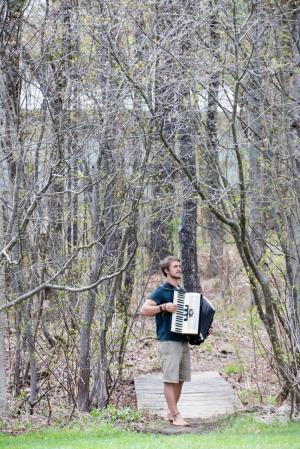 “In my experience, musical inspiration is like a stream: it is always flowing. I am always humming or have a melody in my head,” says Clayton Clemetson ’19, who was well known on campus for playing accordion and piano and singing in ensembles. Marlboro is fortunate that Clayton dips into that stream often, and has been very generous with sharing his compositions for Annual Fund videos enjoyed across the college community.
“In my experience, musical inspiration is like a stream: it is always flowing. I am always humming or have a melody in my head,” says Clayton Clemetson ’19, who was well known on campus for playing accordion and piano and singing in ensembles. Marlboro is fortunate that Clayton dips into that stream often, and has been very generous with sharing his compositions for Annual Fund videos enjoyed across the college community.
“I offered my music to Marlboro because it is a community that I believe in,” says Clayton, who completed his Plan on the transformative potential of holistic education. “Marlboro takes its strength from the diverse talents and passions that the community shares with each other. If we all share the things we love with the people we love, then we are brightening the world for each other.”
Clayton also participated in this spring’s popular Sugar Rush campaign for the Annual Fund, saying that the metaphor of collecting maple sap, a drop at a time, resonated with him. “I donated to Sugar Rush because I want to see Marlboro become stronger financially, and in terms of participation from the student body,” he says.
Although Clayton began classical piano lessons when he was 8 years old, he only wanted to create his own music rather than play music that other people wrote. Since then, he has divided his musical interests between composing for orchestra or film scores and more traditional music: playing piano for contra dances and singing international folk polyphony.
“Eventually I allowed my folk endeavors to overtake my pursuits of orchestration because I found the values around inclusion and community more resonant,” says Clayton. This fall he is a staff member at the High Desert Center, in Colorado, for their gap year program, which is focused on self-directed learning and living in community. The program includes teaching about homesteading, sustainable architecture, social dance, and, thanks to Clayton, social song.
“This is exactly the kind of space that I want to teach in, where teaching and learning is a conversation and an exchange,” says Clayton. “It does not sound so different from Marlboro, where students create tutorials and learn alongside their professors. When two people share that spark of motivation to learn something, very little can get in their way.”
See some of the videos featuring Clayton’s music, or hear more of him at soundcloud.com/clayton-clemetson. Also, read about his recent adventure in Ecuador at marlboro.edu/clemetson. Photo by Kelly Fletcher
Branch Out Gets Upgrade
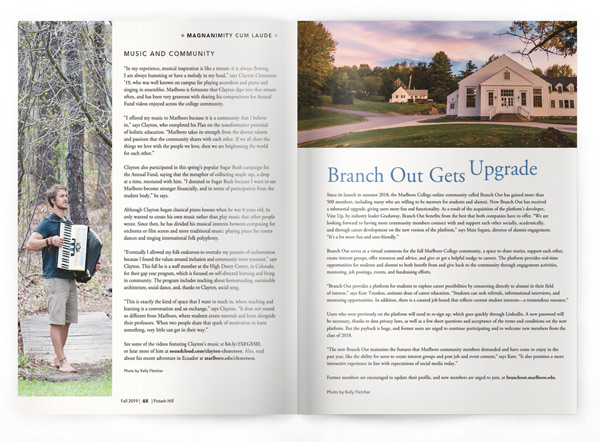
Since its launch in summer 2018, the Marlboro College online community called Branch Out has gained more than 500 members, including many who are willing to be mentors for students and alumni. Now Branch Out has received a substantial upgrade, giving users more fun and functionality. As a result of the acquisition of the platform’s developer, Vine Up, by industry leader Graduway, Branch Out benefits from the best that both companies have to offer. “We are looking forward to having more community members connect with and support each other socially, academically, and through career development on the new version of the platform,” says Maia Segura, director of alumni engagement. “It’s a lot more fun and user-friendly.”
Branch Out serves as a virtual commons for the full Marlboro College community, a space to share stories, support each other, create interest groups, offer resources and advice, and give or get a helpful nudge to careers. The platform provides real-time opportunities for students and alumni to both benefit from and give back to the community through engagement activities, mentoring, job postings, events, and fundraising efforts.
“Branch Out provides a platform for students to explore career possibilities by connecting directly to alumni in their field of interest,” says Kate Trzaskos, assistant dean of career education. “Students can seek referrals, informational interviews, and mentoring opportunities. In addition, there is a curated job board that reflects current student interests—a tremendous resource.”
Users who were previously on the platform will need to re-sign up, which goes quickly through LinkedIn. A new password will be necessary, thanks to data privacy laws, as well as a few short questions and acceptance of the terms and conditions on the new platform. But the payback is huge, and former users are urged to continue participating and to welcome new members from the class of 2018.
“The new Branch Out maintains the features that Marlboro community members demanded and have come to enjoy in the past year, like the ability for users to create interest groups and post job and event content,” says Kate. “It also promises a more interactive experience in line with expectations of social media today.”
Former members are encouraged to update their profile, and new members are urged to join, at branchout.marlboro.edu.
Special Web Features
Understanding the world around you: An interview with Todd Smith
In July, Claire O’Pray ’20 sat down with chemistry professor Todd Smith in the community greenhouse, where they discussed the chemistry of fog, community governance, and sustainability projects on campus.
Claire:When did you come to Marlboro?
Todd: I came to Marlboro in the fall of '99. I was doing a postdoc at the University of Rhode Island and the National Marine Fisheries Service, and was looking for my next job. Postdocs are term-limited: they hire you and they say your job is going to end on this date. And so I was nervous about finding a job, and saw an ad for Marlboro College, maybe in the Chronicle of Higher Education, I'm not really sure. And I sent off a letter and resumé, and didn't hear anything back, didn't hear anything back, was getting more anxious.
Claire: Classic.
T: I came home one day and my wife Jennifer had scrawled on one of our cookbooks a phone number—and I can picture it clearly—in red pen. She said, “You got a call from this guy at Marlboro College and he wants you to call him back.” So I came up here and interviewed and, a short time after that I got an offer and started six or eight weeks later. It was pretty quick.
C: Was the hiring process similar then to how it is now, the student involvement and everything?
T: This was different because when I was hired it was as a visiting professor. So the interview process for those kinds of things is not as involved. It's not as formal. There was not a big search committee that had faculty and students. And I think it was because it was behind schedule, like the semester was going to start. So I just talked to John Hayes (the dean of faculty) and Jenny Ramstetter, and whoever we ran into when we walked around the campus.
C: What do you like about teaching here?
T: I think the number one appeal is the flexibility. I have really come to appreciate the interplay of student and faculty flexibility. There's a lot room for students to negotiate and construct their course of study, and for faculty construct their curriculum. So there's this flexibility, but then the other side of that is this tremendous responsibility. For example, I can simply offer a new course, but then it’s up to me to make sure the content and skill development are appropriate, and that it’s working well as part of my overall curriculum.
C: I get that, in terms of tutorials and Plan in general. Professors are just like, “You to decide what's important”—feels like a big task.
T: That flexibility is huge. Part of that is the small size of the college, being able to talk to colleagues and saying, “What are you doing? Maybe we could do something together?” More recently for me a big change has been the confidence to think about non-traditional, project-based courses. Courses that aren't a topic that's taught traditionally, with a single textbook, and the material in the textbook is the content that students are supposed to get. If you can free yourself from textbooks and what others consider a “standard curriculum” in chemistry, for example, there's a lot more you can do. There was a recent tutorial I did with a student to think about redesigning the compost shed and the whole area around the farm for example. Maybe the first example was a tutorial I did with two students who wanted to build a root cellar. And I said, I don't see it - what's the academic content? I don't know if you can do that. But as I started thinking about the students' enthusiasm for the project, I realized we could design the tutorial around historical context for root cellars, data collection and analysis of temperature and humidity, and construction of a new root cellar in the greenhouse. That interplay of flexibility and responsibility is something that is one of my favorite things about Marlboro.
C: How has Marlboro changed since you got here? It's like the year after I was born, if that makes you feel old.
T: I'm getting that feeling a lot these days. Many aspects of teaching at Marlboro are the same. I think what we've done in the academic sphere, is develop more support structures. There is still the flexibility for students to design their own curriculum. But I feel like we've made more effort to support students in that process. We offer more guidance for students from enrollment through completion of their Plan. We've also worked to connect community governance and the academic program, and now the Marlboro Promise will lead to some additional changes. In thinking about how we deliver the Marlboro Promise, I will change in how I structure my courses to make sure that students develop those skills as they progress through the curriculum. But all of these changes feel like natural evolution, and are the result of a lot of dialogue—a lot of process
C: Do you think community governance has stayed the same or does that change?
T: I think the big change has been the smaller number of students, a result of the declining enrollment. When I came to Marlboro there was a lot of discussion about whether we had too many students. We had around 300 my first year, and then it went up to 325, or something like that, and people were saying it was too many. Particularly the writing faculty. There were faculty whose job it was to deliver all the writing courses, and they were having courses with huge enrollment. They were saying that we can't keep doing this. There're too many students. And then and then enrollment started to slowly decline since then.
C: So do you think that's led to less committee involvement?
T: Yes. I think you were more likely with that bigger pool of students to find people who care deeply about each of the things that needed to happen. And that they care about it, and their friends may not have cared quite as much, but they would support that student. So you have this kind of nucleus and then you had enough students to have people who were interested in the farm, and people who were interested in the soccer team, and people who were interested in the Citizen—all these different activities on campus. And it's been harder to find those students to be the nucleus to kind of step up and say "I want to do this," and I want to be part of making this happen. For all of the Town Meeting committees we have, you need people who were willing to do commit and be part of that, and it has been harder to fill those committees.
C: Yeah, I think especially this this last round of the selectboard we spent so much of our time just trying to fill committee. Everyone on selectboard was on at least one other committee, in addition to selectboard. I mean, our head selectperson was on two other committees. And I think that meant we didn't have the time to dedicate.
T: Right. So we still have people who are committed to community governance, but they're doing more. There are fewer people trying to do the same amount of work, essentially.
C: Yes. Those who are committed say I'm going to do four committees instead of being really committed to the one I care about most.
T: I should just mention that that was another big change—in the academic sphere—to have writing be taught by a wider group of faculty, instead of these dedicated writing teachers. So that's been a big shift, too.
C: I don't take very many STEM classes—I have taken some math—but a lot of my friends do STEM classes, and they were all really happy freshman year to be able to take a writing seminar that was Jenny's biology class. Because they felt like they didn't have to sacrifice a class they were interested in to do the writing requirement.
T: Part of that shift has been having faculty that haven't been teaching writing feeling comfortable incorporating more writing into their classes, so...
C: Have they been starting to feel more comfortable with that because there's been more training for them? Or is it just like an idea that they weren't used to?
T: I think both. I think support—writing faculty saying if you teach a writing seminar they will support you with giving students feedback or thinking about the exercises that we use, the assignments we give. So that's been definitely both. And then once someone like Jenny does it then maybe someone else feels like, well I could probably do that too. I talked to Jenny and she had a good experience, and it was a challenge but a rewarding one.
C: You did a chemistry writing seminar, right?
T: Typically I do one on genetic engineering. And it's definitely for non-specialists, people without background in say biochemistry and molecular biology. It's kind of the current issues. When I first started doing it, there was a lot of excitement about stem cells for example, so we would read about that. We read books and news articles about stem cells but also about the question—and the title of the class—Who's Driving the Train? What's behind this? Where's the money that's paying for this coming from? Who's making money off of this? That kind of focus. Another subject was genetically engineered food crops. You know, who's advocating for that, who's making money off of those products. So I have done multiple versions of that, the first one with Laura Stevenson, who taught writing here for a long time.
C: My mom took a lot of classes with her.
T: Oh, cool! Working with Laura was both kind of intimidating, because she was such an expert, but also—I did that at least two times, maybe three times with her—an experience that gave me some more confidence that I could start teaching a class with a big writing component myself once she retired.
C: Do you think everyone should take chemistry?
T: I don't want say chemistry is so important that everyone should take it in college, but I think it's incredibly valuable for people. But on second thought, yes, I do think everyone should take it. The reason I say that is because chemistry gives you the ability to enrich your understanding of the world around you, to make this connection between what's happening at the atomic and molecular scale and your everyday experiences. Why it's foggy outside, or why some materials are good electrical conductors—you can explain those processes in detail—or even how a solar panel works, your view all these kinds of phenomena becomes deeper and richer.
C: Didn't you have a class in cooking, even?
T: I called it Chemistry in the Kitchen, because it was really supposed to be about chemistry and then the context for that is something that we're familiar with—and most people aren't intimidated by cooking. But you know, I think that's something that we talk about more with students: the way that the different disciplines approach their material is way more similar than not. So in all the different disciplines there's some effort to understand what came before, how we got to this point where we think about the discipline in a particular way, whether it's ceramics or painting or dance or history: what's the history of that discipline; what are the big central organizing ideas in that discipline; and then how do we use those big central organizing ideas to make sense of the world around us. And that's totally the same thing in chemistry. Even if you never took a chemistry class but you had this idea of, okay it's probably built on the ideas of people who came before, and I could read a little bit about that history. And if I want to know more about chemistry there are probably some central organizing ideas, and I could find out what those are. And then I could look for examples of how people use those to make sense of the world. You could do that—we're trying to teach students to learn how to learn. So, yes, people should take chemistry, but even if they don't, it's accessible in a way, and you can use the tools from other disciplines to then explore how ideas in chemistry are related.
C: This is this sort of tangential, but on the Smoky Mountains spring break trip, we were like, what makes the Smoky Mountains smoky? And we looked it up and Charles, who's taken a lot of chemistry, was on the trip and we were like, “Charles, explain.” We just made him decode all of it and explain it.
T: So did you have someone from each discipline on the trip who could make sense of things? You had naturalists, biologists...
C: We had a biologist with Lydia, we had Charles for chemistry. I had history and psychology, Sage does sociology. Flynn does outdoor education, sort of experiential learning stuff.
T: Did Daniel go on the trip?
C: No, he was a senior two. But we had Adam and they have basically similar backgrounds.
T: That's like mini college.
C: What made you involved in the farm? Because I feel like every time I'm here you're here.
T: You know it happened sort of slowly. There was no one moment where I said I have to go and be part of that. I think it was the students who first wanted to build a greenhouse here. And it was not this solid wood frame structure we have now. They were trying to build a hoop house. I really like building, like rough carpentry kind of stuff, and they were looking for help building the wooden frame for this greenhouse. They showed a consistent commitment to it. There are a lot of times when students say “let's do this,” and then that enthusiasm evaporates. But these students had a core group that kept going, and kept working at it. And so I think that's when I first got involved. And then over time it's become clear that the current of environmental studies runs from chemistry through things that people do on the farm. I also started to understand better the idea that if you want to make something happen at Marlboro you probably can, but you have to show a real enduring commitment to it. And then once other students—or particularly one student—said I think we should build a more permanent greenhouse at the farm, I also got interested in that effort—that vision that he had for building a greenhouse and what it could do for the farm. And then once I was a part of that and he was graduating, I think people were looking around, particularly Plant and Operations people, and saying we have another building that we're going to be responsible for. We can't just keep adding buildings. And so I said I'll do what I can to help be responsible for that building. So that's kind of where we are now.
C: So has it been like that sense of responsibility that's kept you involved? Because I feel like student interest in the farm has waxed and waned over time. We're sort of on an uptick now but when I got here there definitely wasn't the same interest that there is now.
T: I mean it's partly that commitment. But also, as I said, I've gotten more comfortable doing project-based classes and tutorials. And the opportunity that this farm and greenhouse presents, to be a kind of classroom for those experiences as a kind of ongoing experiment, seems really fantastic. It's just an incredible resource to have. And so I also get excited about saying, let's try and use it in some way for project based classes and tutorials. I also really like the idea of trying to illustrate for students, for actually the whole campus community, what a resource this greenhouse is. Whether it's trying to grow greens year around, store food in the root cellar, or assess the performance of the solar panels, it provides the potential for so many class and Plan projects. So yeah, it's kind of a two-fold commitment to it.
C: What about the sustainability project coordinator that used to be Tanner, sort of, but now is you. What's your involvement in that and what does it look like?
T: The president in the past few years has secured funding for the Environmental Advisory Committee, and that committee has had a lot of flexibility in how to allocate those funds. And so last year with that big chunk of money the president and the EAC decided to try funding a sustainability project manager position which I agreed to do, with a course release. So it came from Kevin and the EAC, which has the larger goal of advising the president on environmental policy and environmental and sustainability goals, and advancing these goals on campus. This is a topic I've been very interested in, so when the president said “would you be willing to do this” I thought, well, I can't say no. I've already been trying to do a lot of these things. And so it was the intersection of my involvement with the EAC, this opportunity for funding, and my past work, for examle on the farm and greenhouse. I think it was a good way to advance projects, but it's also kind of an eye-opener how much work it still takes to get things done.
C: What projects have you had a hand in?
T: Well, when I look back I think about coordinating and getting in place the summer farm intern and the ecological reserve intern. Those seem really big to me. The other one is that I spent a lot of time on an electric vehicle charging station. The college got a grant from the state to support the installation of EV charging station. Working with colleagues to prepare that grant, soliciting bids for the work, and now organizing the actual installation, the whole project has taken a lot of time. The installation is probably going to happen at end of the summer. So the interns—farm and ecological reserve—and the electric vehicle charging station, I think are the two biggest things. One of the things students in the past asked for was Wi-Fi in the greenhouse. So we spent a lot of time trying to wrangle or advocate for buying the equipment, getting that installed, and that still took something like a year and a half or two years. That's kind of a minor thing. I've also spent more time on the Real Food Challenge, and trying to maintain the composting dining hall waste during the academic year.
C: Do you know how that's going to change with regard to new composting laws that are going into effect soon?
T: I don't know if anything's really going to change. What I hear is there's really no enforcement for that. There's the law, but no one's going to be coming around with a clipboard saying “show me how you're doing this.” It could be as simple as the company that does our trash hauling offers compost dumpsters, and they'll haul that separately. We could hire them to add that onto our waste contract. But then there's a local farmer who raises pigs and he's been asking certain times of the year for the food scraps to feed to his pigs, which seems fine—we don't have to pay for it, he hauls it away—but then it shuts down at times of the year. And we generate a fair amount of pre-consumer food waste, and we don't have any place for that to go. So I don't know if you can stop and start the compost dumpster the way the farmer stops and starts his pickup for the pigs. Another big sustainability project coordinator effort was the tutorial to reimagine the whole area between the greenhouse and the parking lot, and to inspire some change. Because the way it looks right now is sort of this accidental, an unplanned progression of steps instead of a holistic idea. We want to rebuild the compost shed as part of that project, and the president has committed funds for that rebuilding. So that's exciting, and this effort connects to your question about what happens to our food waste. The idea is to build a system that would be able to handle much more waste. It wouldn't necessarily be sized to take all of it. The big problem is turning a pile of compost, doing that by hand is difficult. But if we can use the college tractor a couple of times a month to turn it, and then shift it, we could compost more food waste.
C: I've been much more positive about the compost after talking to Jacob, the summer farm intern. Because I was bemoaning how hard compost has been since I've been here. He said, Oh it's much better than a lot of other places I know. And I was like, sweet! He said it actually gets hot enough to decompose things.
Remembering Grant Li
Tributes to Grant Li still to come! Send yours to Seth Harter at harter@marlboro.edu.